-
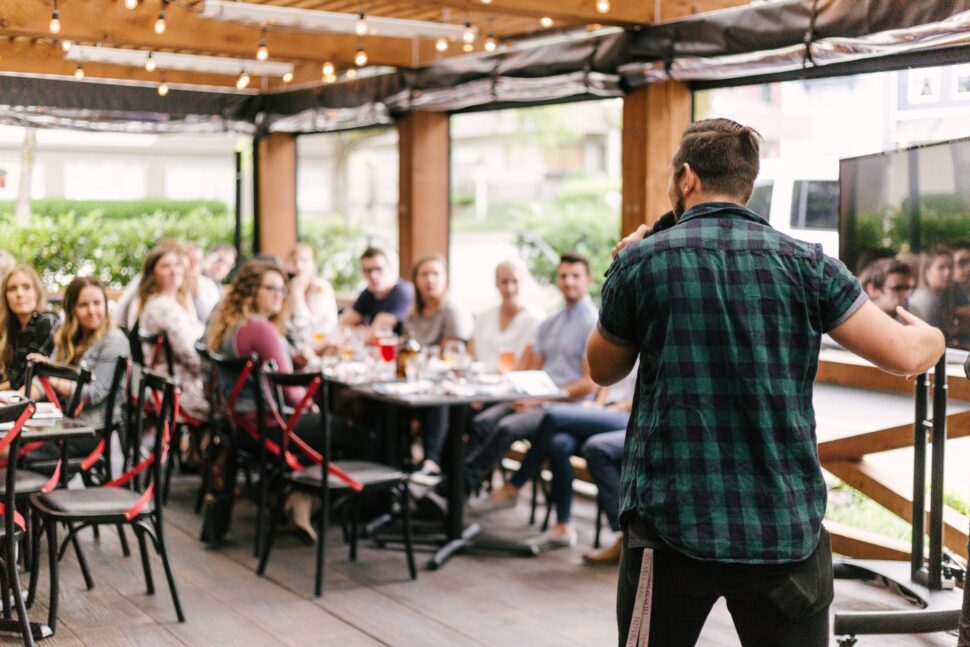
Get involved today with our new fundraising kits!
Want to get involved with Recovery Beyond and aren’t sure where to start?
How about becoming a Recovery Beyond Fundraiser and starting your own campaign? You can help others live healthy lifestyles for lasting recovery by setting up your own fundraiser today. What you do matters and has a greater ripple effect than you’ll ever know. We know YOU can make a difference in helping us achieve our mission. You’re just a few clicks away from helping someone change their life.
We are excited to implement our new fundraising kit here at Recovery Beyond. This kit is available to anyone who would like to fundraise with us. It’s simple and easy to use. You’ll be given the tools you need to be successful at fundraising.
Need a reason to fundraise? Fundraisers are a thoughtful way to memorialize a loved one, to celebrate a birthday or special occasion, and so much more. Are you riding in a race, running a long course, climbing a mountain, wanting to support those in recovery, or simply just being an amazing human being through your mere existence? Get others involved in what you’re doing and start a campaign today.
All campaigns benefit Recovery Beyond. We thank you from the bottom of our hearts for your interest in helping us achieve our mission of helping others live healthy lifestyles through lasting recovery.
We can’t wait to see you achieve your fundraising goals and will be here to support you along the way!
To get started, view the Fundraising Kit.
2 -
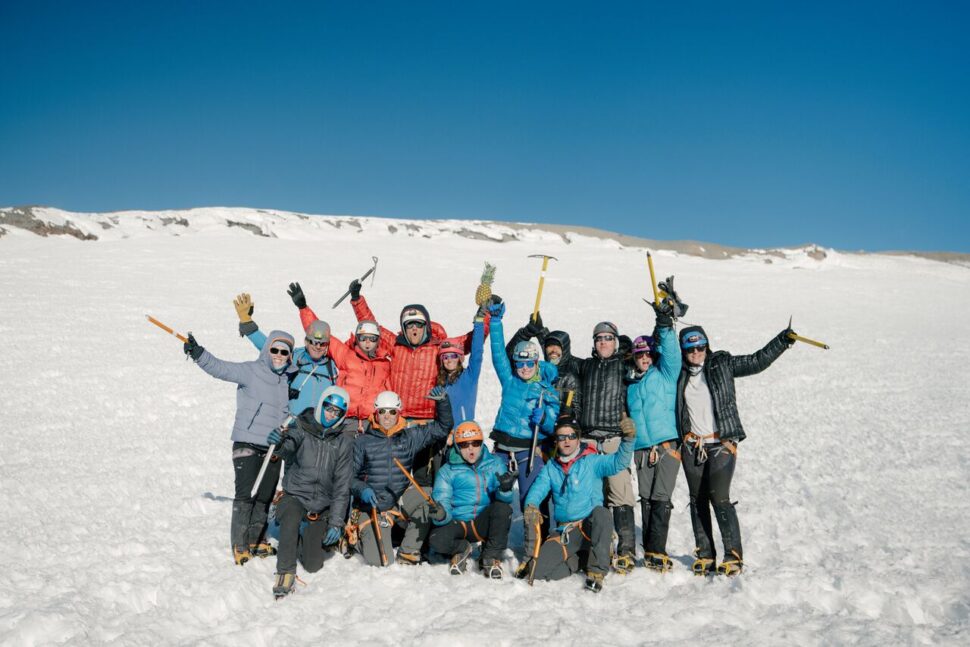
Success is MORE than a Summit
Mountaineering is not an easy sport. It requires intense physical strength, training, practice, patience, and an admirable mental fortitude. The odds may be stacked against the mountaineer at times, but the way the mountaineer handles an unexpected, undesirable, potentially unsafe situation is by far the most inspirational of all the things a mountaineer can do. Reaching the summit is exciting, but the real success lies within the mountaineer’s decision-making skills on safety and awareness of personal limits.
Everyone is following their own path in life and is developing their abilities and skills within their own timeframe. They are doing what is authentic to them. Not everyone is built for mountaineering; it’s a tough activity. It’s an impressive feat to even get part of the way up a mountain. The amount of time, dedication, training, and perseverance that goes into that alone is amazing. Let’s not forget that the National Park Service only allows so many people up on the mountain at a time, too!
Defining success is relative to each person in question. Success may be reaching the summit. Success may be getting to a new high point on the mountain. Success is choosing to stop drinking or using and taking the first steps to change. Success is being one hour sober, one day sober, one week sober, one month, one year, and so on. Success to some may be getting out of bed in the morning. Success to others may be getting a highly sought-after career position or completing a difficult project or working through a hard diagnosis. Success is pushing oneself to achieve something greater than what one already possesses whether it be physical, mental, emotional, or spiritual. Everyone is different and everyone has their own measure of success. Most importantly, everyone can be successful if they try. It’s as simple as that.
60 people participated in Recovery Beyond’s program last year. Recovery Beyond works with both the Seattle Union Gospel Mission and Tacoma Rescue Mission. Program participants with Recovery Beyond are also involved in programming with these two rescue missions and maybe on a different trajectory than the timeline Recovery Beyond has available. Life circumstances such as acquiring a job, moving, or graduating from the rescue mission’s programs may result in an individual moving on from Recovery Beyond’s program before completing the program. Graduating from Recovery Beyond’s program doesn’t define that person’s success, though, just as summiting a mountain doesn’t necessarily define success for a mountaineer. Graduations, new jobs, new homes – these individuals are quite successful! Even if they have to leave our program early, they benefit from the skills they have learned and from the relationships formed during their involvement.
Success at Recovery Beyond is not a mountain summit. It’s a new high. It’s re-establishing a connection with a community of support. It’s creating new, healthy relationships. It’s getting that new job or that new home because of a healthy lifestyle. It’s being roped up together in life and celebrating each other’s unique achievements. Recovery Beyond believes that everyone has their own measure of success and that individual successes should be celebrated!
The journey is almost always better than the destination. The best part? The views keep on getting better and better. Starting this fall, the view is about to get a whole lot better with Recovery Beyond as we introduce our new Climbing Up program. Climbing Up will be open to anyone interested in being part of a sober community that focuses on healthy lifestyles for lasting recovery. New programs, new relationships, new ways for the community to be involved, and new supports are all waiting to help individuals continue to be successful and flourish.
How will you continue to define your own success? How will you share your success? Stay tuned for more information on how to be a part of our Climbing Up program!
-
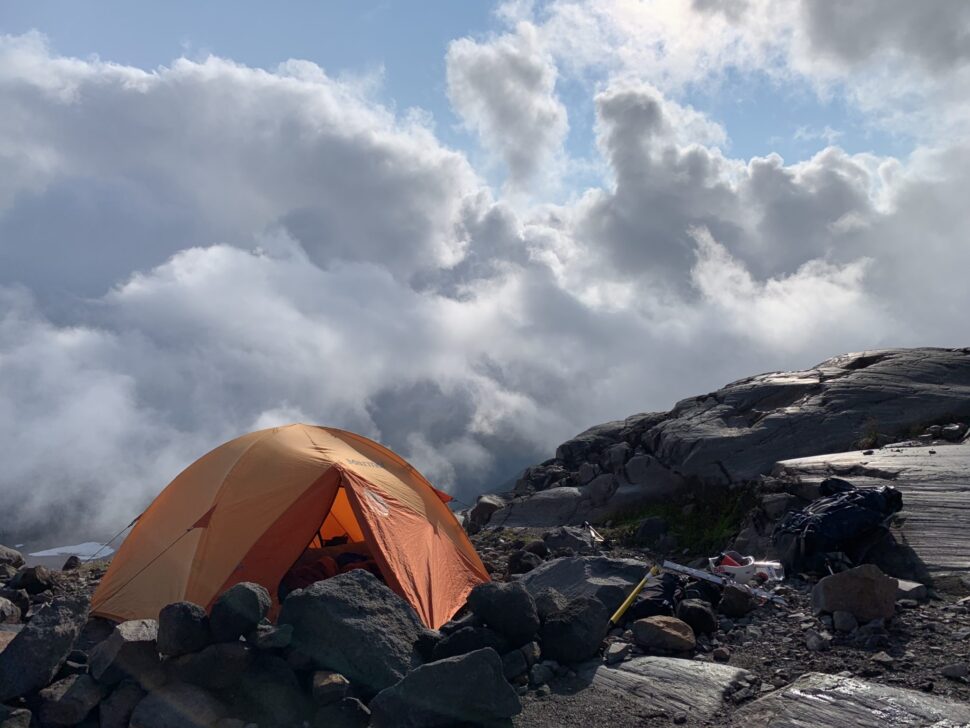
Final Climb of 2019: Mount Baker
Roping up on the mountain and in life
On Thursday, July 18th, through Saturday, July 20th, Recovery Beyond’s mountaineering program, with combined leaders and participants from Tacoma Rescue Mission and Seattle Union Gospel Mission, went on their second and last multi-day mountaineering trip of the year to Mount Baker. The trip was split into three days. On day one, the team reviewed travel and approach. On day two, the team camped and reviewed skills training. And, on day three, the team attempted a summit, descent, and traveled home. For any of our participants to qualify for this climb, they had to meet a certain number of other physical requirements, including hikes and a previous climb.
Day 1: Review of Travel and Approach
Weather: 50’s, overcast and cool, with light rain for the first couple of hours of the ascent
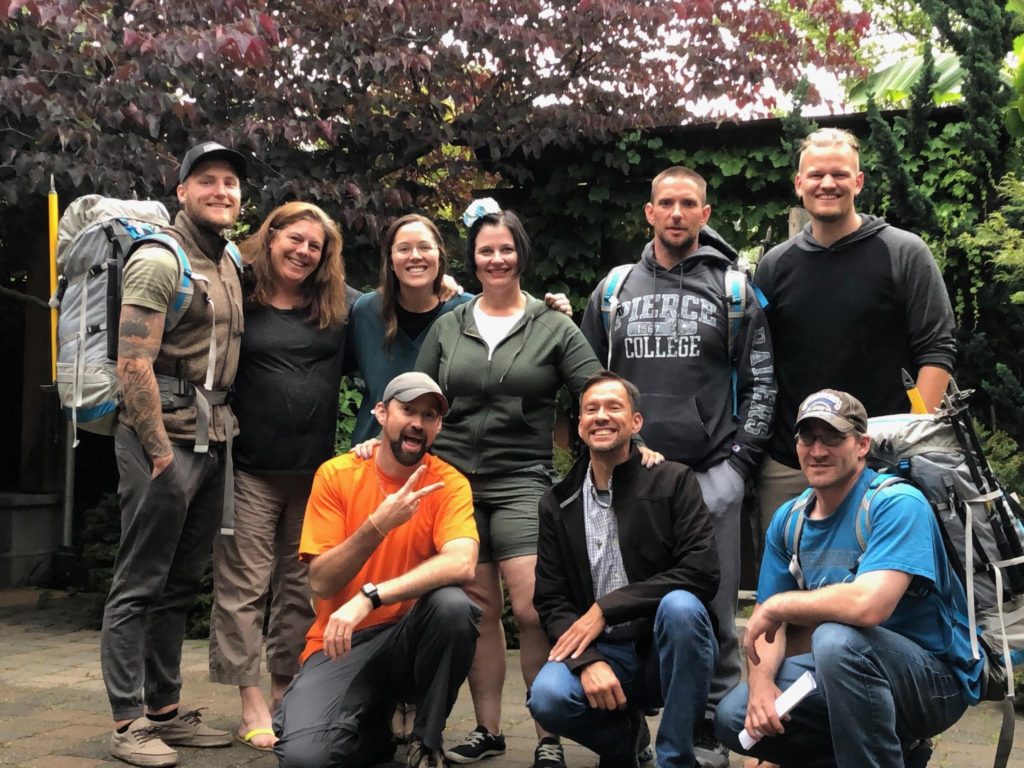
Mt. Baker Briefing (left to right, top row: Shadow, Sarah, Alison, Becky, Kyle, Nate, bottom row: Scott, Jason, Jeremiah)
On the morning of the 18th at 7:00 AM, the team set out from Riverton Place Union Gospel Mission in Burien, Washington for the Mount Baker-Easton Glacier climb beginning at Park Butte trailhead. After a quick coffee stop, the team arrived at the trailhead at 11 am and began getting their gear prepared while also enjoying additional snacks and water. At 12 pm, the team set out on the trail with a plan to arrive at camp around 4:00 pm, hiking for an hour or so, taking a ten-minute break, and then continuing with this pattern until camp was reached. Once the team reached camp, they set up tents and a kitchen/eating area. Around 6:30 pm, dinner and reflections of the day were both shared as a group. The team reviewed travel and approach. At 9:00 pm, the team went to bed, ready to rest for the night.
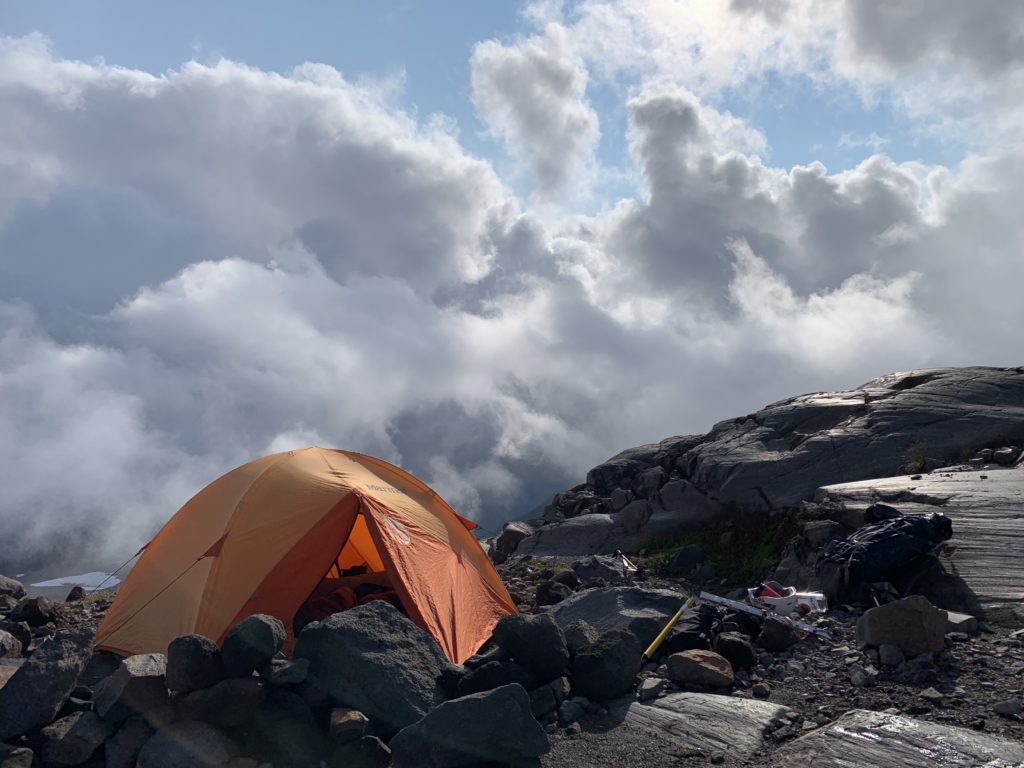
Recovery Beyond Basecamp tent, team leader tent, 9600’
Day 2: Camping and Skills Review
Weather: 50’s, low-visibility with clouds, eventually breaking open to some sun and sights of the mountain
The team arose at 7:00 am, had breakfast, and by 9:30 am prepared to review snow school skills for Cascade glacier travel. The leaders led the skills training, covering the review of an ice axe, cramponing, and the self-arrest maneuver. After practicing rope travel, walking on a rope, stepping over the rope, rope intervals, and communicating as a team, everyone set off to eat lunch and rest. Around 3:30 pm, the team ate an early dinner, and had a team meeting at 4:30 pm. Everyone prepared their packs, crampons, ice axe, helmet, clothing, food, and water for the climb the next morning.
One of our team members, Sarah, found the ascent to be more challenging than expected. The team came up with a new plan for her, which was an important call and one that had been discussed during the weeks leading up to the climb. There was a beautiful hike to a fire look-out nearby on a well-marked trail, and the next morning Sarah planned to hike to the fire look-out with Becky, one of the team leaders.The entire group went to be around 6 pm, with a wake-up call of 1 am for those climbing to the summit. Sarah and Becky had a wake-up time of 7 am.
Day 3: Summit, Descent, and Travel Home
Weather: 50’s and clear with gorgeous, endless views
The team woke up at 1 am, ate hot oatmeal, and were roped-up and ready to begin the climb by 2:15 am. They hiked for about an hour and twenty minutes before taking a break at 3:30 am and continued this hiking-and-taking-a break pattern until 5 am. At this time, they were 1,000’ from the summit. The group was traveling well and showing strength and endurance. At 6:30 am, the team arrived at the summit! They took some photos, high-fived one another, and enjoyed the gorgeous views.
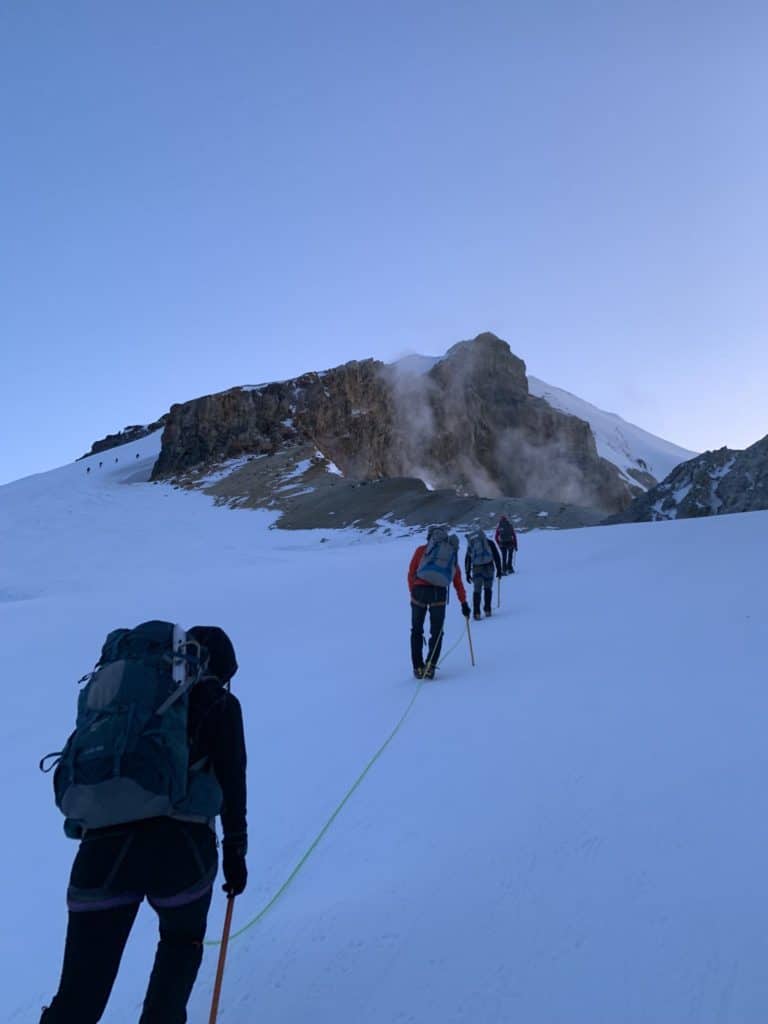
Team 1 approaching the mountains craters edge, fumaroles venting gaseous steam, an awesome sight!

On the Summit! (left to right: Jeremiah, Scott, Shadow, Nate, Kyle, Jason, Alison, McKenzie)
The began their descent an hour later and arrived back to camp around 10:00 am. At 8:30 am, Becky and Sarah had headed off on their own side-adventure to the fire look-out to enjoy the mountain and the beautiful views from a different perspective. The original plan was for both parties to meet up on the trail, and through thorough communication, ended up deciding to just reconvene at the trailhead.
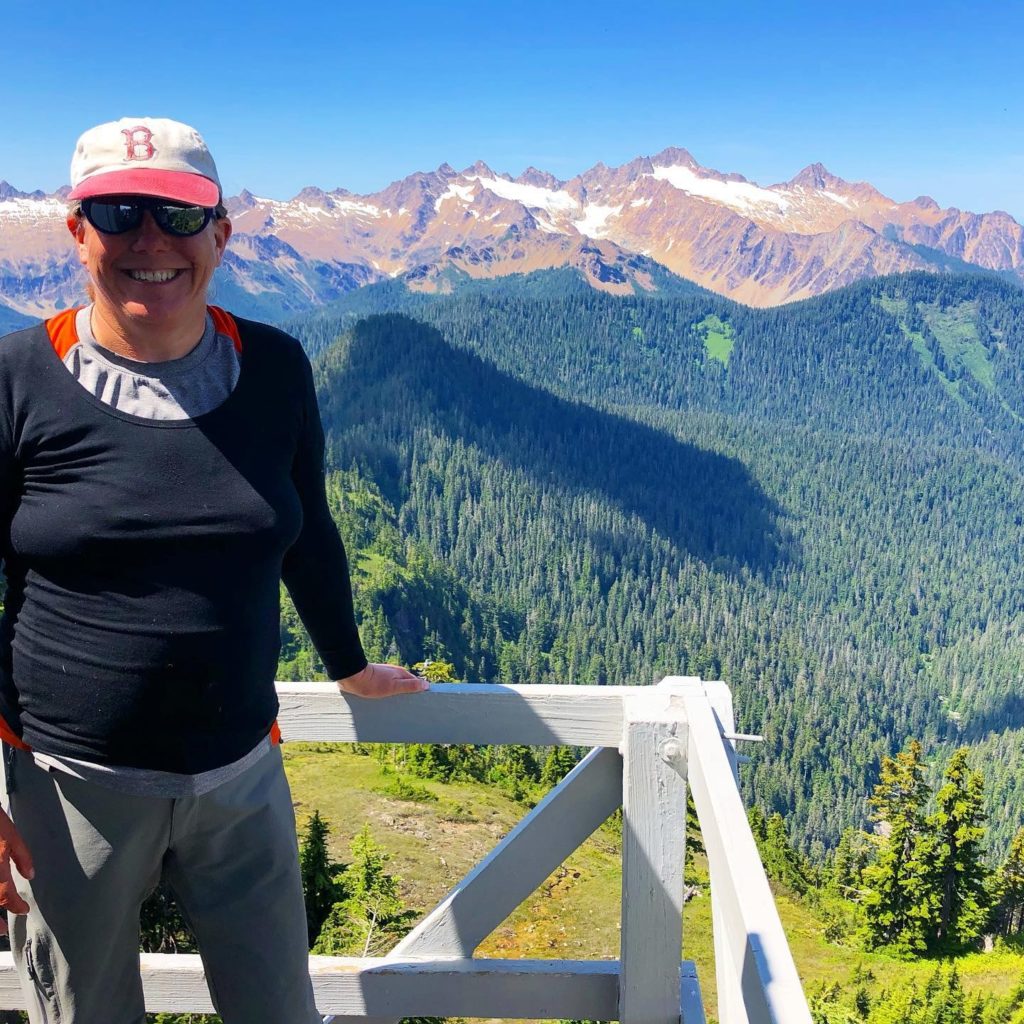
(Sarah Effert’s high point, Park Butte Fire Lookout! Great work!)
Once back at camp, the climbers took a short rest, and then began to pack up the camp. At 11:30 am, the team set off back downhill. By 3:00 pm, they had arrived back to the trailhead, meeting up with Becky and Sarah.
As per usual, the next stop was a well-earned dinner followed by travel back home!Reflection
The climb was a success. The whole team had the pleasure of enjoying gorgeous views that morning while reflecting on their journey in life to get to that point. Recovery Beyond believes that team-building and relationship-building are important factors for maintaining lasting sobriety. This trip wouldn’t have been successful without a team in place who knew how to trust and communicate with each other. The concept of roping-up together applies not only to mountaineering, but to life off the mountain as well. Being able to build healthy relationships and to feel support from one another is how we ultimately find our new high points in life. Our team supports our program participants by listening to them, advocating for them, mentoring them, and by simply being a good friend to them. Our success rate for our participants is high. These healthy relationships, evident in the success of this trip, help create healthy lifestyles for lasting recovery, which is the mission of Recovery Beyond.

Happy Faces after a successful ascent (left to right: Shadow, Scott, Jeremiah, Nate)
If you’d like to make a gift today to further our mission and allow others the opportunity to participate in this program, please consider making a donation today. Our team thanks you so much!
-
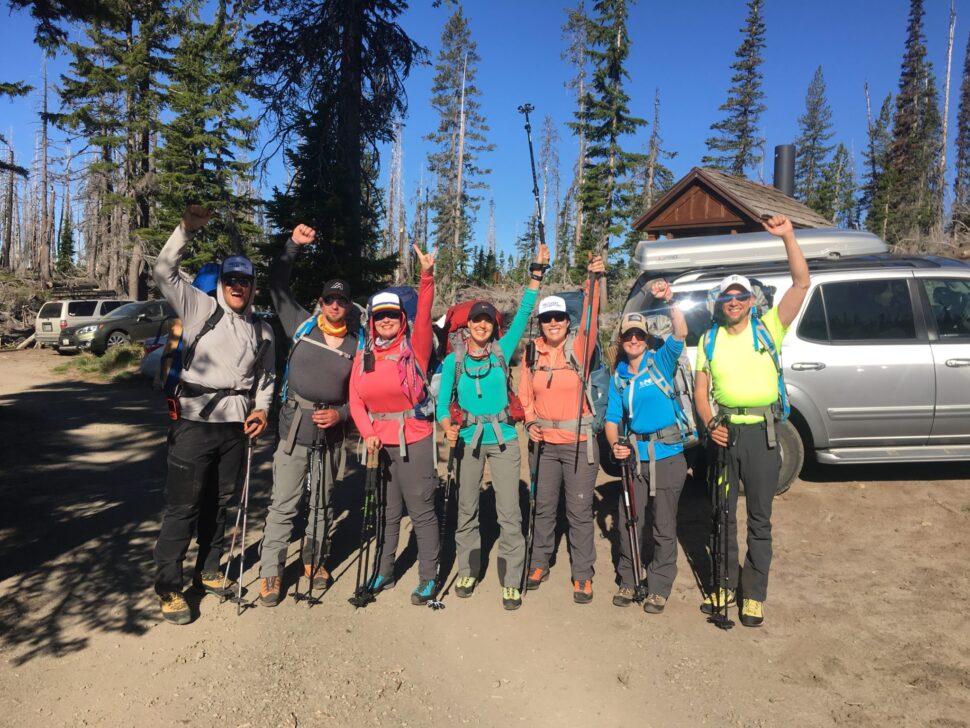
“Success is More than a Summit” Mount Adams Climbs, June 2019
On June 7,8, and 9 and June 14, 15, and 16, our Seattle and Tacoma mountaineering teams attempted their first mountain climb of the year up 12,280’ Mount Adams. Each team member had to train rigorously for this climb and had to attend 100{637c4c527fde39f83a380e19107d2ba88ad72607f37ccf8f8b7edeff1c20688c} of the training in order to qualify for a spot on the climb. Training hikes included Tiger Cable Line, Mount Si, Mailbox Peak, and Camp Muir, all of which are difficult hikes that require prior conditioning. Participants had to attend a day of snow school as well.
The Mount Adams trip for each team was split up into three days. Day One: Travel & Gear Check; Day Two: Approach and Camp; Day Three: Summit Attempt, Decent, and Travel Home.
DAY 1: Preparing for the Climb + Dinner Tradition
Each team set out on a Friday morning to spend the night at “Camp Jonah”, an old high school converted into a Christian camp, in Trout Lake, Washington. After a quick lunch stop in Hood River, the teams arrived at the camp by mid-afternoon to practice working with their gear, dividing up team equipment, and properly packing each pack.
A Recovery Beyond tradition before every climb is to bring the entire team together for a special dinner. In this case, both teams enjoyed a meal at Trout Lake Country Inn. This dinner is an opportunity for all to reflect on the great accomplishments achieved so far in each person’s recovery, the hard work that went into training for the climb, and the relationships that were formed along the way. Each participant also discussed how climbing Mount Adams fits into their own recovery journey.
There were many positive recovery-focused and healing sentiments shared by each person at the table. One participant from our Seattle team mentioned that being part of Recovery Beyond has been one of the most helpful things in her recovery. This organization has given her renewed self-confidence and healing, both through new physical strength, allowing her the ability to do things she couldn’t do before, and through being accepted by the community of Recovery Beyond.
DAY 2: Up to Lunch Counter
The following morning, each team left Camp Jonah and drove to the Cold Spring Campground and trailhead for the Mount Adams south climbing route (5,600’), the route that each team would take. The approach this day was all about method. Everyone climbed to the next campsite at 9,300’ with loaded packs while also taking extra “fueling” breaks.
After about 6 hours of hiking, the teams arrived at their overnight camping destination on a natural mountain shelf called “Lunch Counter”. Here they set-up and shoveled out a proper snow tent platform, a kitchen area, and designated bathroom area. Camp setup took most of the rest of the afternoon, Dinner followed and then the climbers were able to get some much-needed rest for the summit push the next morning.
One thing that was noted by most of the newer climbers that evening, while eating dinner, was how beautiful the camp area was. They stated that it may be one of the most spectacular places they have ever camped.

DAY 3: The Summit Push – 12,280’
Early the next morning at around 2 AM, the climbers awoke, ate hot oatmeal, finalized the last prep of their packs, and put their crampons on to begin the summit push. The goal was to leave camp by 3 AM. Shortly after everyone was ready to go, headlamps were turned on and the climbers ventured out into the cold, dark night with one goal in mind: to climb Mount Adams.
When mountaineering, the goal is to, of course, leave very early, but to also push for about 1,000’ of elevation gain per hour, take a short break, and then repeat until the summit is reached or it becomes too hazardous to continue.
This was the strategy that Recovery Beyond climbers adopted for this climb. They knew they had 3,000 feet to climb from Lunch Counter to the summit, so there would be three stretches to get to the top.
The outcome? Each participant from both the Seattle and Tacoma team got to their own personal high point; some higher than they thought they could go, others reaching the summit. Each climber was filled with pride and satisfaction for what they had accomplished.
By mid-morning, they arrived back to camp, rested for 30-40 minutes in their tents, then packed up camp. The Tacoma team enjoyed a nice glissade down (sliding down the snow on your bottom!) while the Seattle team got to further practice their route finding on their way down. Each team made it back safe and sound, having built deeper relationships with themselves, each other, and a higher power.
What was next on the docket? Cheeseburgers. With all those calories burned mountaineering, our teams were in dire need of something delicious to consume! So off they went.
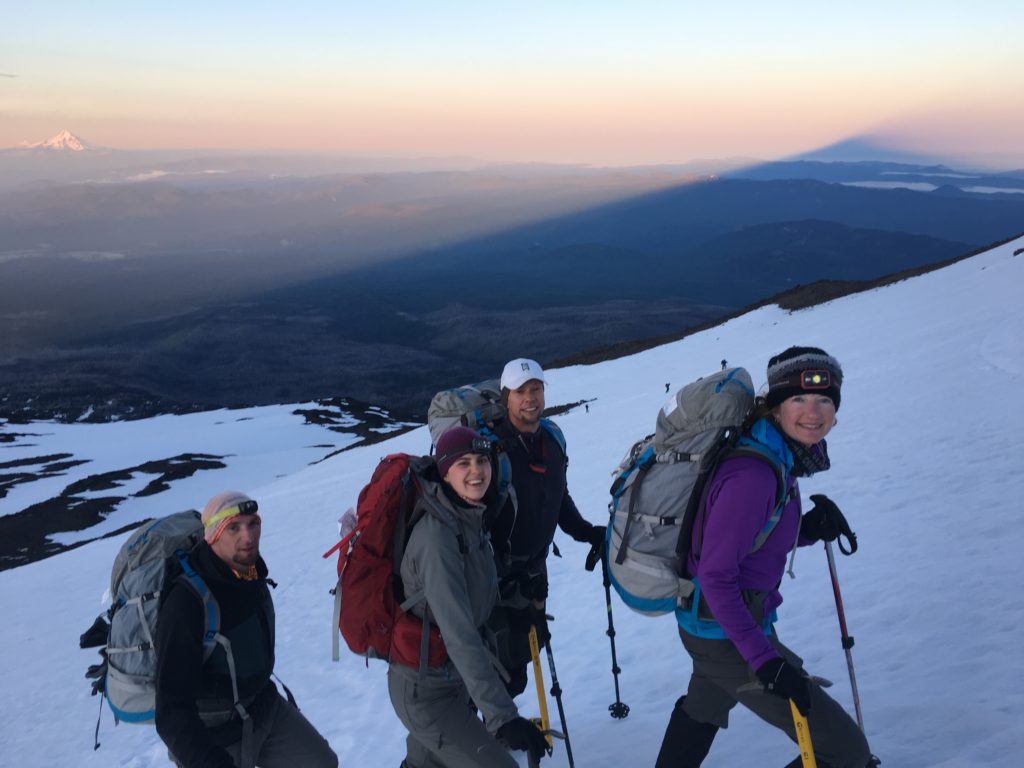
The Result
Perseverance, team-work, and extensive training and conditioning led to successful climbs for all. At the end of the day, it’s never about the summit. It’s about the journey, sobriety, new relationships, new experiences, and the idea of achieving something that has required extensive dedication. We are proud of the accomplishments of all our climbers. Everyone met their own new “high” and that is amazing.
Climbing Mount Adams, whether getting part of the way up or summiting, is quite a feat. There is nothing like the beauty of the mountainside to make one’s soul sing and the sweat and burning muscles of a climb to realize what we are physically capable of when we truly push ourselves.
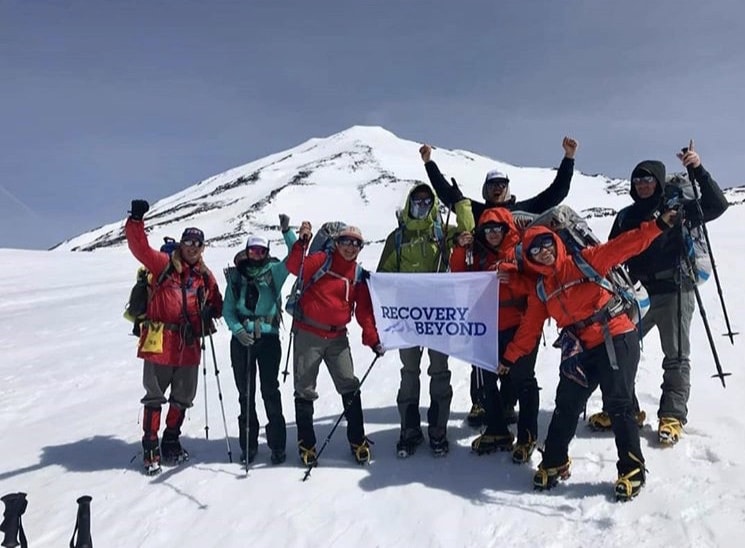
Our climbing teams will be climbing Mount Baker next week (July 17-20) and we couldn’t be more proud, supportive, and encouraging of their next great move. Stay tuned to hear all about this climb. We wish them good luck (they’ve got this!) and great weather!
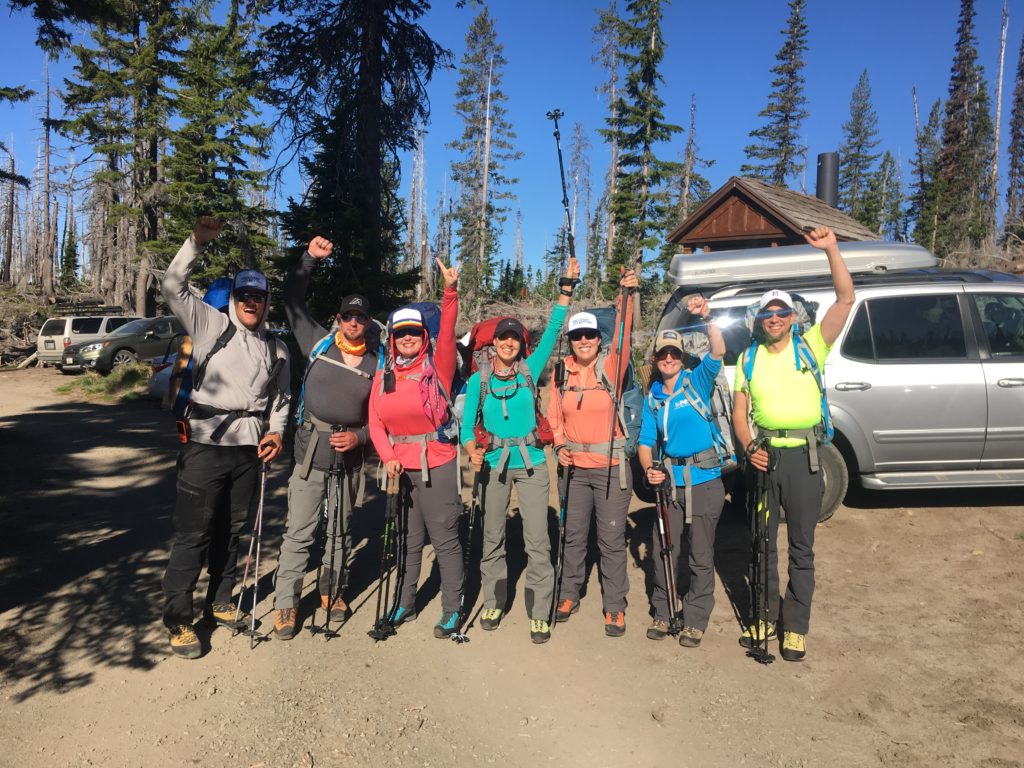
How You Can Help
Our community provides essential support to our climbers in different ways, such as mountaineer training for big climbs such as Mount Adams and Mount Baker. Will you support our program participants to ensure lasting recovery by making a small gift today? Most importantly, please keep their safety and long-term sobriety in your prayers. We each have our own mountain to climb, by working together, we’re all able to find our personal best. Thank you for your support.
CONTRIBUTE TODAY! -
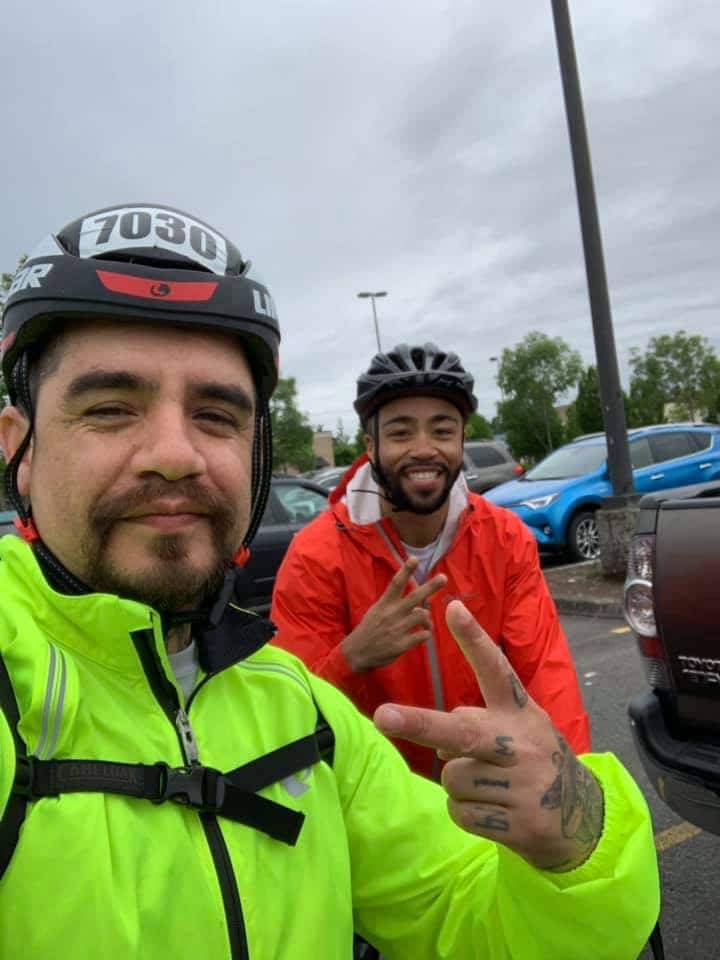
From Seattle To Portland, Riding For Recovery
“The Ability to Feel Again is My Greatest Reward”
The mountains have been one of several healers for Jose, who, by the grace of God, will be sober for 11 years on August 29, 2019. Sitting across the table from him at the XXX Diner in Issaquah, he sits with a warm smile on his face, his heart on his sleeve, and shares his story of addiction, recovery, God, his mother, and how he found Recovery Beyond.
Journey into Drugs and Alcohol
The path to drugs and alcohol was easily accessible to Jose at a young age. They provided an escape from reality and pain. He began drinking and got drunk for the first time when he was just eleven years old. That summer in Oregon, where he was born and raised, was a blur. Marijuana followed and so did the trouble. By the time Jose turned seventeen, he had three felonies, with charges ranging from minor in possession to felony gun possession and everything in between. He candidly describes the time there was a gang shoot-out down the street from him. Bullets whizzing by his head, left and right, he grabbed his niece who was playing outside in the front yard and threw her back into the house to save her.
Jose knew he was a rough kid. No person, child or adult, should ever have to endure the types of abuse, violence, poverty, and hard situations he saw and experienced. His mom did all she could to protect and provide for her children and get them involved in programs at the YWCA, but kids often have other agendas. His Grandma was a CPS director for many years and helped when she could through programs she had access to. Jose remembers food bank lines, Christmas baskets, and programs at churches. He remembers finding his mom in her bedroom closet crying because she couldn’t afford Christmas presents that year. He told her it was ok and not to worry. He remembers holding her as she wept.
Cocaine was the next drug to come along. He was introduced to it when he was 19, and initially used it to make money. It eventually became the mechanism he needed for his own use. He and other individuals would rob drug dealers at gunpoint to steal their drugs. Crack cocaine…crystal meth. They would take the cocaine and make crack to resell. The purer the cocaine they could get, the better the crack, and the more customers they would have. It was a good business plan for the situation they were in, and along with this plan came the parties, the girls, and the hotels. Money went fast. Real fast. By the time he was introduced to heroin, he realized he had stepped into territory from which he may never return.
He knew he needed to stop.
He made several attempts to stop using and get help. He graduated from Lakeside-Milam treatment ten years ago, started attending church, and ultimately got full custody of his four children, whom he shared with a woman who ran with him and his drug use.
He has been together with his current wife for nine years. He met her after he had been clean for two years, so she doesn’t know him in his addiction. He knows himself, though, and knows the warning signs and has warned her about them. He knows if he starts using again that he will run through her emotions and mental state like a hurricane and won’t think twice about it.
Jose will look you straight in the eye and tell you that he is blessed to be alive.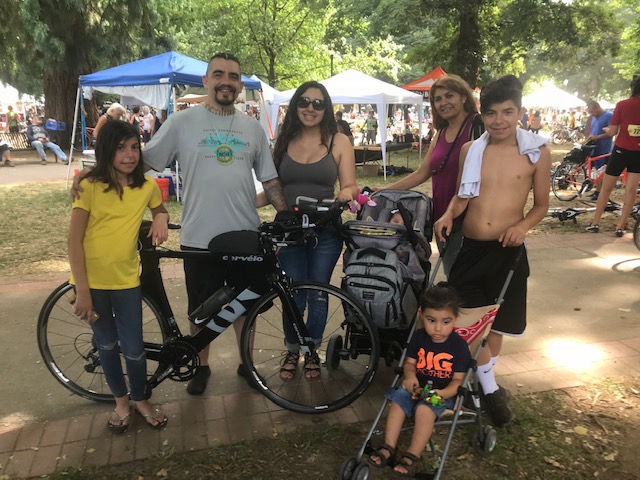
A Mom Who Did It All
“Leave your surfboards at home. Allow the waves to wash over you. Allow the grief to overtake you. If you know how to ride it correctly, you’ll ride it smoothly down. If not, you’ll fall off and that’s ok. When you allow those waves to take you and toss you around, you can look at them and say, ‘I survived this one, I can survive the next one.’ They build you.”
Two years ago, Jose abruptly and tragically lost his mother. A single mother, she did it all. She raised five children, was the pillar of her family, and at the time of her sudden and unexpected death, was three months sober and so proud of it.
After her death, Jose remembers looking up at the sky, begging for God to slow down. He didn’t call his sponsor. He didn’t hike. He did nothing. Jose was on a mission to get loaded, so he turned his phone off, got dressed, and left. The last thing he wanted to do was feel. His wife asked where he was going, and he said, “I’ll be back.”
Jose went to a bar.
The bartender greeted him saying, “Hey sweetie, how’s it going?” He ordered three double shots of tequila and scooted up close to the bar. Inhaling deeply, he picked up one of the shots, held it to his nose, smelled it, and then put it down.
His hands shook.
He looked to the sky.
The bartender walked by looking at him oddly. Jose hadn’t taken the shots yet and was aware that he was being watched. He asked for a Coca Cola to chase the tequila down as if to buy him time. After he realized what he was doing, a wave came over him and the tears started.
The bartender walked by, again, looked at him, and saw that he was crying. Really crying. Jose was trying to hold the tears in. Sniffling, he put his hand on his hip, and his finger felt something in his fifth pocket. He fiddled around and pulled the object out.
It was his three-year coin.He can’t begin to tell you why that coin was there that day. Maybe he wore those pants to a meeting. But of all the pants to wear that day, of all the objects that could be in the pocket of the pants worn on that day, this was the one that was there. And it was just what he needed.
He pulled it out of his pocket and cried. He slammed the coin on the table with affirmation.
That bartender turned right around and looked. She saw the coin, looked at his tearful face, grabbed his drinks, pulled them away and said, “Sir, I need you to leave right now. You need to get out of here, honey.”
Jose grabbed the coin and stuck it in his pocket, reached into his other pocket for his wallet to pay, which the bartender refused to accept.
“You better get the hell out of here and never come back,” she said. Jose apologized for wasting the tequila and she looked at him and said, “Just GO.”
This is the one time that he felt closest to a relapse.
What did he do next? In order to counter the feelings he was having over the death of his mother, he took on a lot of extra activities to counterbalance his emotions. He didn’t want to feel but had to fight this thing within him, his addiction, with everything he had. If he went back to using, he would be useless to everyone. He knew he would pick up right where he left off.
So he started biking. Hiking. Doing Hot Yoga and Brazilian Jiu-Jitsu. Picture this: an ex-gang member, in and out of jail, covered from head to toe in tattoos, who grew up in rough neighborhoods, can now be found doing hot yoga, breathing, wearing yoga pants and a tank top, running, and exercising.Jose did every physical activity he could get his hands on. It was difficult for others to understand the magnitude of what was going on inside him. A lot of people said, “Slow down.”
These were his healers, however. Biking, hiking, jiu-jitsu, hot yoga, and, of course, God. These things propelled Jose into the activities he does now.
A few months ago, Jose was at work and walked past the opening of a garage, not even thinking of his mom. A breeze blew through sending along with it the smell of his mom’s perfume, a perfume she had received every Christmas as a gift from Jose. Jose said, “Mom?” and turned to look for her. He saw a woman, who was not his mother, standing by the garage opening. She must’ve been wearing that perfume. It was heartbreaking and crushing for him. As much as he didn’t want to feel the things he was feeling at that moment, he had to ride that wave. Because he has learned how to manage his feelings, he knows how to let the waves of emotions come and go.
Church, The Mountains, and Community
Church also changed for him. He remembers ten years ago leaving everything on the floor for God. Jose said, “God, take it all, strip me down to the bones, rewire me into the person I’m meant to be when I came down to this Earth.”
At an altar he recalls someone putting a hand on his shoulder, and then another hand on his other shoulder. He didn’t know who it was but knew someone was there with him. He remembers turning around after an ocean of tears, a spiritual cleansing, if you will, and seeing thirty to forty people with their hands on each other’s shoulders in prayer over him. There was this whole, powerful community, and it was amazing.
Community is so important.
Jose served in the children’s ministry, as an usher, at the welcome center, in the group for those with alcoholism and addiction, and in forgiveness classes for men ages 12-60. But after his mom’s funeral service, it was too painful for him to return. So he found church elsewhere, but this time without four walls and this time in a more intimate way with God.
For a few years, Jose had been solo hiking. He had been yearning, praying, and asking for God to meet him in some way, in some form, and God has been doing just that. Jose has been and still is drawn to the mountains and believes that God calls him where he wants to be. That’s where he goes and stays faithful. Ten out of ten times, God is right. Even though church has been very important to Jose in the past, he believes that God is now leading him into the classroom of silence; that he must enter alone to understand himself better. Yes, God is always right in that space, even if Jose doesn’t understand it right away.
On a hike to High Rock lookout, Jose went in as an emotional wreck. Once he got to the lookout and went inside, he noticed something etched into one of the walls. It said, “Greater is he who the mountains bow before”.
He felt chills. He felt like God was there with him. Without a doubt, he knew He was there.
On another hike to Thunder Lake, Jose separated from friends and was walking alone. There were beautiful wildflowers in bloom everywhere. “Touch of Heaven” by Hillsong had just played on his music playlist. He was missing his mom. All of a sudden, the clouds broke open. Jose was so overcome with emotion that he fell to his knees and let God’s spirit wash over him.
An army of butterflies propelled out of the surrounding landscape, hit, and bounced off of Jose and then flew away.
He was crying. “Ugly, baby face crying” as he so eloquently put it. He got up and passed another hiker who asked if he was alright and Jose said, “I’ve never been better.”
“I had done Mailbox earlier this year, sunset hike, 3 AM. I swear there were cougars out, so I had a machete and gun, every couple of steps stopping, did you hear that? I got up there, saw the sunrise, and it was beautiful. That was a moment between me and God. That’s my church up there. It’s very real, very raw. Me and God are on another level. God wants me in my purest form, broken, raw, alone, teachable, open. He wants the nitty gritty, he wants to do a spiritual gardening in me, yanking out weeds, in purgatory, being purged of all these things…”
Community. Jose was looking for a community of sober hikers and ways to help people in recovery when he stumbled across a post about Recovery Beyond by McKenzie Johnson on a popular Facebook hiking and climbing page called the Washington Hikers and Climbers. He reached out to McKenzie, was connected with Nate, Recovery Beyond Program Manager, and everything snowballed from there. Jose wanted to share what he’s been given with other people, and now he had the opportunity.
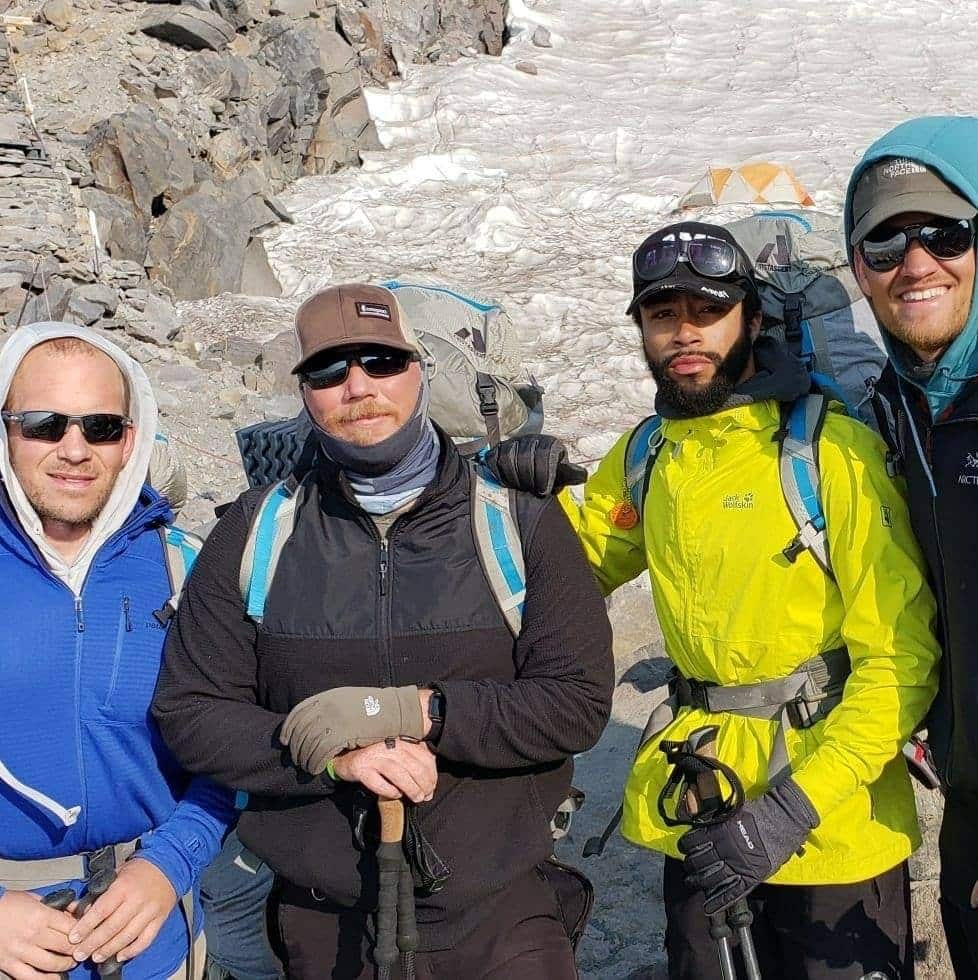
His first hike with Recovery Beyond was Mailbox Peak. He gravitated toward a participant named Jason who was newer in his recovery and they hiked together and shared stories. He admits that he walked into this hike with a bit of ego, but toward the end of the hike, he found himself changed and inspired by those he hiked with. He was humbled by this experience.
Conviction
“In my recovery, there isn’t one thing that I haven’t asked for that God hasn’t given me. It happens In His own time though.”
Tattooed across Jose’s knuckles is a gentle reminder to “Sink or Swim”, a simple and perfect metaphor to live by.
At times, Jose admits he’s guilty of wanting to force things, manipulate things, and control things. We all do this and then we are confused as to why things don’t work out the way we want them to. It’s not until later that we may understand why things had to happen a certain way. Jose states that God has a really funny sense of humor and that if you want to make God laugh, tell him your plans. You have to let things go and let God take control, and that’s hard, Jose says. He wonders, how do I get to where God is calling me?
He tells people in recovery that he understands the disease part. It’s in his genetics – his mom, uncles, and cousins all have addictions. He states, “I can only speak for myself. The disease is there…I have a choice, though. (He motions to the glass of water in front of him) If I choose to pick up that glass of water, put it to my mouth – that’s a choice. The moment the water enters my mouth, that’s where the disease kicks in.” And that’s where he sees the difference between choice and disease.
Addiction is a medical, psychological, social, and individual issue. It’s not easily fixable. People need people because we are social creatures and we need positive reinforcement. No one teaches us that, so it must be learned. Those with addiction are very emotional people. If they’re ready for help at 12:57 and no one shows up till 1:00, then they’re already using. By creating community, you put a person in a place where that window of opportunity is now just a little bit bigger.
Mirror in the Jungle
“So we’re doing this hike up to Mailbox… and Tyler or Jason, one of the two, said, hey man, have you ever seen the video of the dude who goes up in the jungle and puts his mirror up with a video camera and lets it run so the animals see it and react?”
Jose thought about this and then it hit him. “Wait a minute you guys”, he said, “listen to what you just said! That’s us. We’re the animal out in the wild! Imagine living your entire life never looking at yourself in the mirror. We’re out here looking at ourselves for the very first time. For 17 years I was using and never looked in a spiritual mirror. When someone gave me a mirror, I saw who I really was, who I had become, and I didn’t like it. I was confused – I didn’t use to be this person.”
“That’s why I like going out to the mountains – there’s no Facebook, wife, kids, work… it’s just me and God. In His creation, sometimes I get so overwhelmed emotionally. You see these landscapes, the beauty in them, and it’s just like, wow- how? All he did was just *poof*. And then you think to yourself, what else is out there? This is just a teeny tiny sliver of what’s out there. What’s in Colorado or the other side of the world? Makes you start thinking. It’s inspiring – I want to go see these things. We are only here for a short time…We have a bag full of excuses. At what point do we take that bag and toss it aside and actually go out and live?”
Spiritual Hole
“Shake me as much as you can, [God], I’m not going to fight you.”
It wasn’t until 3 years into his recovery that something occurred to Jose that was mind-blowing. The best thing he had given himself in his sobriety was the ability to feel. Feeling was the one thing he tried to escape for seventeen years. He was finally able to feel all emotions, the good and the bad, to feel them honestly, with nothing in between, unfiltered, uncensored, and in their rawest and purest form. He has had to embrace those feelings because that’s where the healing comes from.
Why would you want to mask that?
Life isn’t good all the time, and we may ask why, why right now? But the ability to feel, the excitement, the joy, the happiness, the euphoric joy, and the darkest times, is something Jose states he would not trade for anything. When he thinks about relapse, he thinks about how he wouldn’t be able to feel anymore. He knows how to manage his feelings now. Managing feelings can be taught. If you get the tools to work your way through it, then you can use those skills over and over. Again, choices.
“There’s nothing that anyone could’ve told me when I was using that would’ve changed my mind to get sober. There’s nothing that anyone can tell me in my recovery that would convince me to start using again. It’s in the person. You can work and try and lead a horse to water, but if the person isn’t willing to do so then it won’t work for them. This is why people have to go through recovery seven times.”
Being in the mountains, on the mat, out on the trails on his bike, all of these things help him to prioritize everything in his life.
STP Ride: Seattle to Portland, 206 Miles, July 13-14, 2019
Building Healthy Lifestyles for Lasting RecoveryThis is Jose’s third year participating in STP. The ride has become his annual emotional retreat. He first started this race the year his mom passed away. This year, Jose is doing the race for his mom.
He got his first bike at work: he found a bike that had been locked to a place where it shouldn’t have been locked. The manager said to clip it and get rid of it. Jose asked if he could take the bike, the manager said ok, and Jose started riding. A month later, he found out about the STP ride and entered himself to participate. He went 115 out of 206 miles but had to call it quits. Despite his mental fortitude, his legs and knees refused to do any more. He called his wife and she came and picked him up.

Even though he hardly trained for this ride, he was disappointed that he didn’t make it the whole way. The lesson? You must go through a season of preparation, as with all things in life, a lesson that Jose learned on this first ride.
The next year, he joined up with the Cascade Bicycle Club and started to train. They provided a great wealth of information for him. He also found other bikers to ride with and they committed to each other to do the STP ride. Along the ride, Jose encountered many riders who were also in recovery. On his second year of participating in this race, they made it the whole way to Portland.
Jason, who is new in recovery, who met Jose on Mailbox Peak, expressed interest in riding. They have been training together and are looking forward to the upcoming STP ride.
It’s amazing what happens when connections are made and community is created. It’s amazing how one life changes for the better and can influence and support the change in another life. Being able to support others in recovery in something Jose wants to do and now has the opportunity. He is thankful to have found the community he needed in Recovery Beyond.
Please consider a gift to Jose or Jason’s fundraising page for the STP race. All funds will go toward supporting program participants and expanding programming for Recovery Beyond. We thank you for supporting our organization and our growing community. We couldn’t do what we do without you.
DONATE TO JOSE’S CAMPAIGN DONATE TO JASON’S CAMPAIGN -
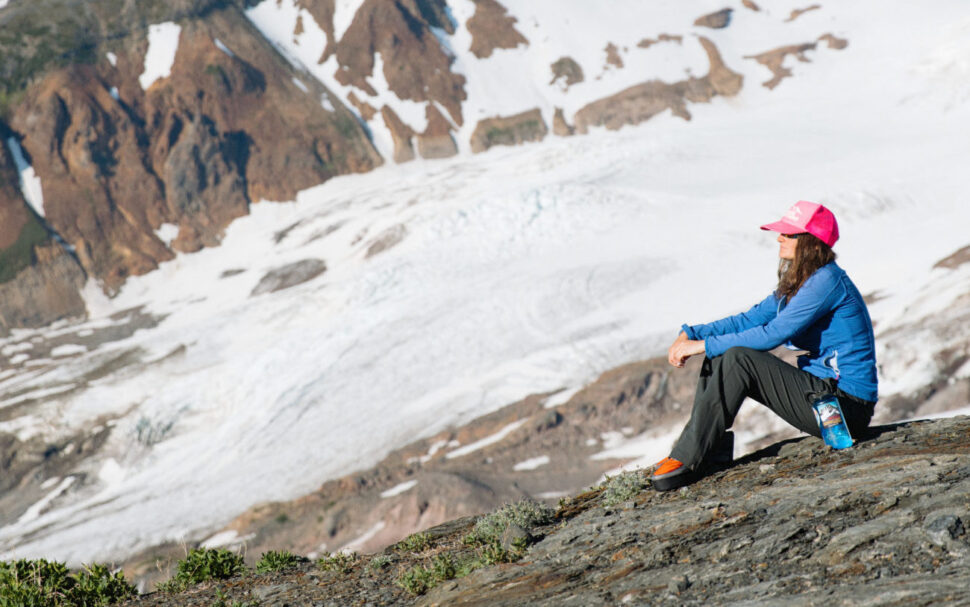
McKenzie Johnson, a Recovery Beyond Super Volunteer
If you’ve ever checked out Recovery Beyond’s Facebook page or Instagram account, you’re more than likely familiar with the friendly, smiling face of McKenzie Johnson, one of Recovery Beyond’s “super” volunteers. In the photos shared, you might see her standing atop a mountain she’s just climbed grinning from ear to ear or proudly posing with a group of Recovery Beyond’s program participants on a training hike that she has led. If you’re like me, you may know McKenzie’s name from a Washington Facebook hiking and climbing page called the Washington Hikers and Climbers, a place where McKenzie has shared her story of recovery and adventures in the mountains over the years.
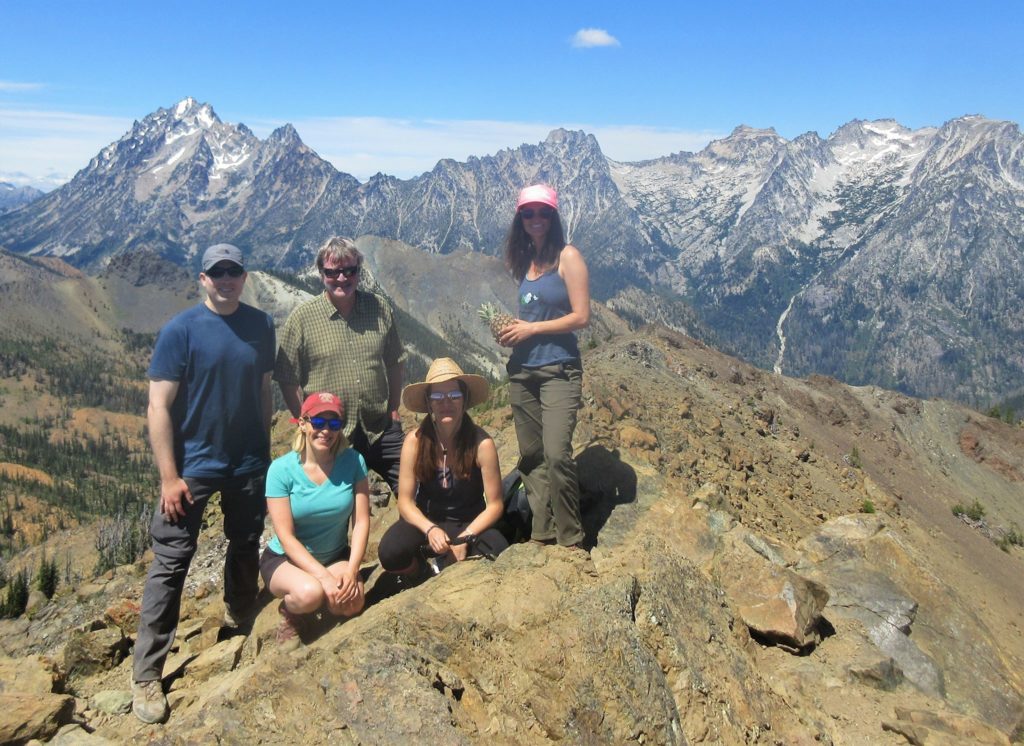
Photo Courtesy: Lee Jacbonson, Washington Hikers & Climbers
McKenzie is very involved with her community and the causes that are closest to her heart. The creator of Washington Hikers and Climbers, Lee Jacobson, stated, “[McKenzie] is a rock star on the WHC page, and last year, I auctioned off a hike with her on the page (to Earl Peak), and we raised more than $2,600.00 for Kittias County Search and Rescue.” Professionally, McKenzie fights blood cancers with The Leukemia and Lymphoma Society through fundraising. She coordinates and promotes The Winter Pineapple Classic, a 5K Obstacle Course fundraiser and promotes and fundraises for another LLS physical challenge, The Big Climb. She does this for her mom and for loved ones and friends of loved ones who have blood cancer or have lost someone to blood cancer.
About a year and a half ago, Nate Lanting, Program Manager for Recovery Beyond, reached out to McKenzie via the Washington Hikers and Climbers group. He asked her if she had seen, A New High, a documentary about Recovery Beyond program participants from the Seattle Union Gospel Mission who trained and climbed Rainier. McKenzie had her whole family watch the documentary, excitedly feeling a connection to many of the program participants. A few weeks later, she messaged Nate back and asked how he got gear for Recovery Beyond’s program participants. She then offered to help the organization get gear donations. That’s when her relationship with Recovery Beyond began.
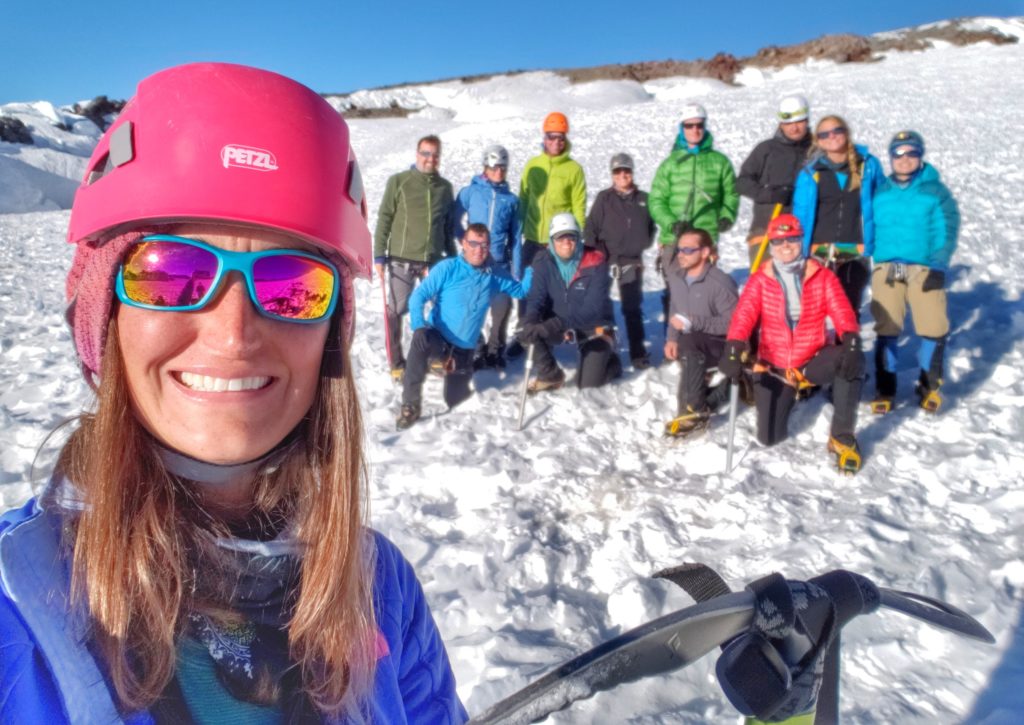
“McKenzie is on the front lines, bringing our message of hope and community to the larger recovery and mountaineering communities in the Seattle/Tacoma area. Her efforts on our social platforms and through her work as a volunteer have taken the organization to new heights and driven awareness for our cause in ways we couldn’t have imagined.” – Christopher Mohs, Marketing and Digital Volunteer
McKenzie’s passion for Recovery Beyond stems from her personal experience in recovery. McKenzie has been in recovery from alcoholism for almost 7 years (June 20th will be 7 years) and kindly shared her whole story with me. She grew up in Seattle in an upper-middle-class family and had a relatively normal childhood. However, she blamed her parents for certain things (later in recovery it became clear that her parents were never the problem), and in high school developed an eating disorder. She wanted to be as independent of her family as possible after high school in order to “hide” her addiction, so she moved down to California to attended CalPoly college. As a soccer player, she could’ve played competitively, but a preconceived idea of what the college experience was supposed to be like caused her to focus more on drinking. Her eating disorder eventually morphed into alcoholism and she became a full-blown alcoholic.
McKenzie made herself independent from her parents so they couldn’t have control over her life. She tried to outrun her addiction but eventually realized that because addiction existed in her head, she could never outrun it. She lived in California for ten years, moved to Australia for a year, and then moved back to California. She knew for two years before she got sober that she needed to stop drinking. McKenzie’s sister was a driving force for getting her into treatment. In 2012, she finally asked for help and went to treatment in Vancouver, Canada for five and a half months. It was there that she was taken to a climbing gym, one of the activities that were offered as part of the program. Despite her fear of heights, she fell in love.
While in treatment, her dad packed up her stuff in California and drove it to Seattle. Once she finished treatment, McKenzie had no place to go except home, which was a place she was scared to face again. Home was where everything had started for her. After she finished treatment, she went back to Seattle, though. She went to AA but wanted to keep her focus on recovery with a hobby she enjoyed as well. Knowing how much she had enjoyed climbing while in treatment, she decided to join Stone Gardens. She took classes, met a friend, and started climbing outside.
As McKenzie got more and more into climbing, her mom grew increasingly concerned for her safety. She suggested that McKenzie look into climbing with Alpine Ascents. McKenzie picked up a 6-day mountaineering course on Baker with only four months to train, and even though it was the hardest thing she has ever had to do, it was also the most amazing. She fell in love with glaciers on this climb. To this day, it’s where she wants to be. She says she’ll never forget the weather because it went from being awful (pouring rain) to being amazing on summit day. After this climb, she started climbing more independently, took an immediate course the following year, and then climbed Rainier in 2014.
One of the biggest takeaways from treatment McKenzie says is that you CAN have fun without drinking or doing drugs. Successful recovery requires more than just attending AA and therapy. Finding a hobby is just as important and climbing became her hobby. The mountains have been a huge part of her recovery. Her family has also been incredibly supportive.
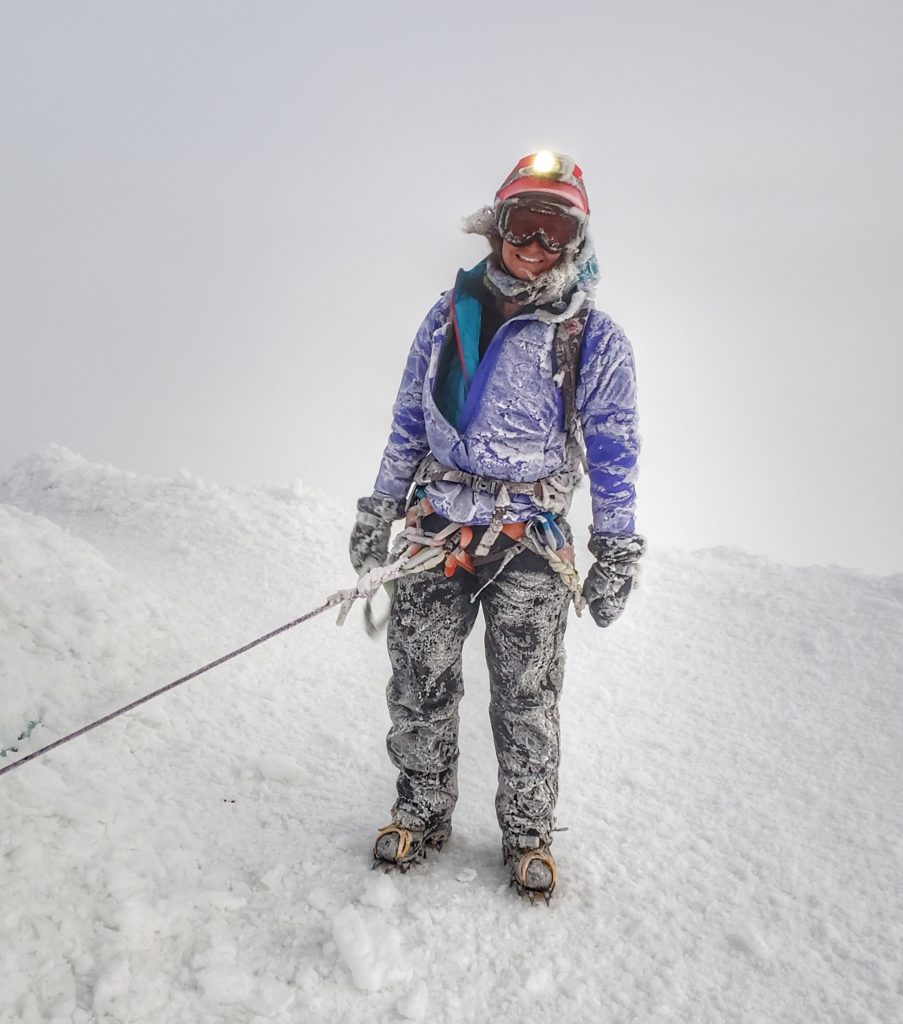
“You may not know it, but McKenzie has played a huge ‘behind the scenes’ role in supporting and growing Recovery Beyond. Between her in-field leadership, recovery mentorship, running countless errands, regular program advising, managing our social channels, and sharing her large network of resources with us, she has played a significant part on our team. McKenzie is hands-down the most supportive and helpful volunteer we have, she might as well work for Recovery Beyond! But I think she likes it that way; a way to give back, to recover, to enjoy the organization, while staying behind the scenes and watching it grow. She has given so much, and we couldn’t do this stuff without her. Period.
I think the best example that displays this is how she has shown up. McKenzie has been at nearly every hike, lead on every mountain trip, been at every briefing and orientation, volunteer hours getting gear and meal packs prepared, opened her family’s studio for us to use 3-4 times for community events.
She is smart, constantly giving good advice about organizational development, or who should meet who for recovery reasons, as well as executes any responsibilities delegated to her.” -Nate Lanting, Recovery Beyond Program Manager
When a person is filled with passion in the way that McKenzie is, it is hard not to feel inspired by them. After talking to her on the phone, her humble and down to Earth nature makes me wonder if she is fully aware of the impact she is having on others. She is authentic, strong, selfless, and grounded. She truly believes that you can do anything you set your mind to. Even though the hikes and workouts that Recovery Beyond offers can be physically hard, she believes that they are nothing compared to what program participants have been through with their addictions. McKenzie inspires others and encourages them to be who they want to be and to challenge themselves. She relates to the participants because she sees herself in them. Her recovery story is like their stories. McKenzie’s biggest pleasure now is seeing someone’s face light up with joy when they go outside.
Back to that “super” volunteer concept: What is a “super” volunteer, you may ask? McKenzie. Hands down, McKenzie. I asked her how many hours she has put into the organization, and last year she said she volunteered about eight to ten hours a week of her time. She went on every hike except one. She helps with social media and is a lead mountaineer guide on teams. What doesn’t she do? To top it all off, she is AIARE2 certified and WFR certified. And she is an ice climber.
“McKenzie is one of those people who just exudes life – she is constantly on the go and working to make things better for others. She is always ready to offer good ideas and to roll up her sleeves to make things happen. McKenzie excels at anything related to social media and getting a message across. She has relentlessly volunteered her time and talent for Recovery Beyond in ways too numerous to count. What a pleasure she is to have involved and to working on our behalf. We can’t thank her enough.” – Gina Haines, Executive Director of Recovery Beyond
McKenzie gets way more out of her experience with Recovery Beyond than she puts into it, she says. She believes that volunteering is a great thing in and of itself, but she also believes that it makes you a better person and helps you grow. McKenzie would like to thank Nate, Becky, and all the program participants who have become like family to her.
To anyone interested in volunteering with Recovery Beyond, McKenzie states that it is a growing organization and that you can seriously make a difference. If you want to help, don’t be shy about it! Send your ideas our way. Even something as small as sharing our Facebook posts or one story on a page makes a difference.
Follow your passions, she says.
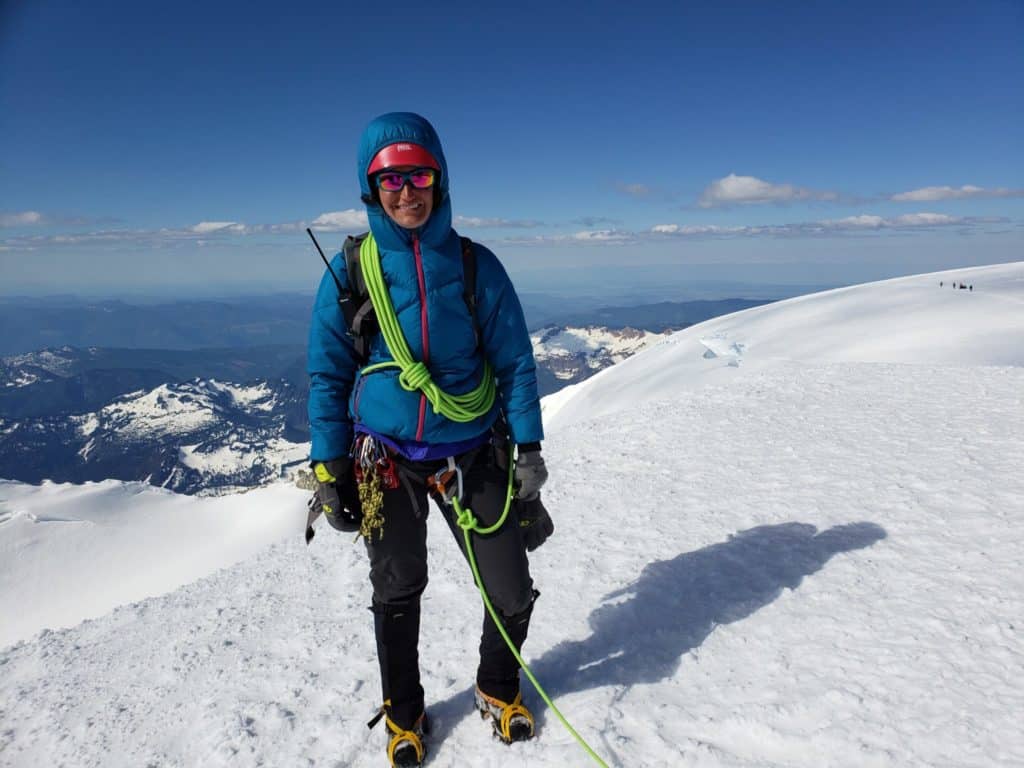
Thank you, McKenzie, for helping our program participants be successful in their recovery. This is why we’re here and why we do what we do. Thank you for everything you have done and continue to do to make this organization what it is today – to build healthy lifestyles for lasting recovery. You are appreciated more than you will ever know and Recovery Beyond is beyond thankful for your time, your dedication, your skills, your encouragement, your compassion, and your selfless and giving nature.
It’s amazing what the mountains can do for someone, how they can change lives, and what can happen when you know you can do anything you set your mind to.
Happy climbing, McKenzie!
-
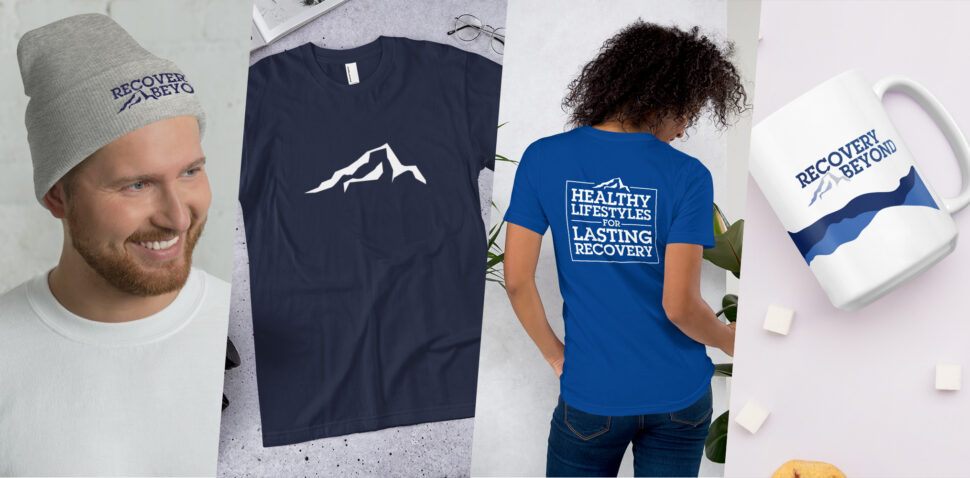
NOW OPEN! The Recovery Beyond Shop
“There are only two days in the year that nothing can be done. One is called yesterday and the other is called tomorrow, so today is the right day to love, believe, do and mostly live.” – Dalai Lama
So, you love to climb, you love supporting our recovery climbers, and you’re a big fan of the work of Recovery Beyond? Well, now’s your chance to wear that pride with the introduction of our new shop! We just launched a series of products that highlight our new brand and we think you’ll love them!
The new shop benefits our recovery climbers and our programs. We curated a range of clothing options, a motivational poster, coffee mug, and some great hats for your next climb.
Check out the store and show your support for Recovery Beyond! We also invite you to tag @recoverybp when sporting your favorite Recovery Beyond logo wear, we’d love to see your new threads.
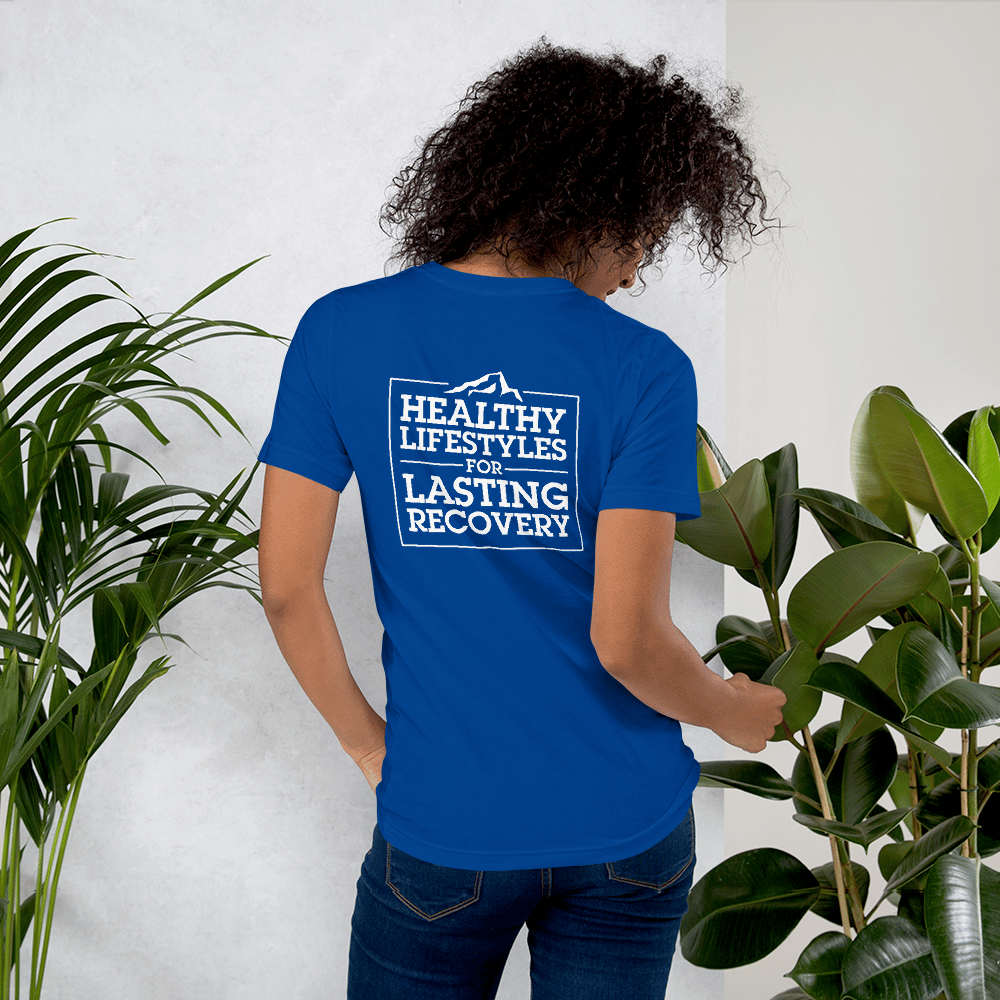
Unisex t-shirt in true-royal blue featuring our tagline “Health Lifestyles for Lasting Recovery” on the back and our logo on the front. $30
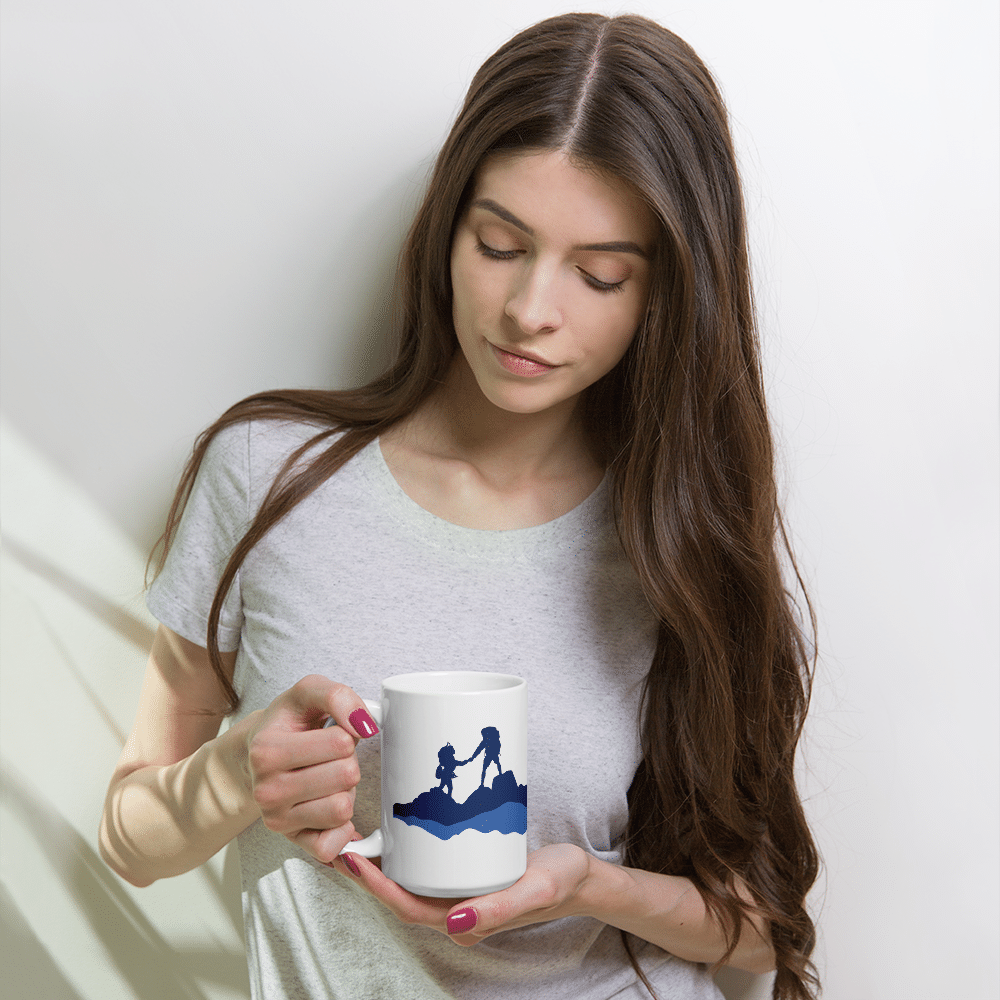
15 ounce coffee mug with our climber motif and a wrap of mountains to our Recovery Beyond Logo on the reverse side. $15
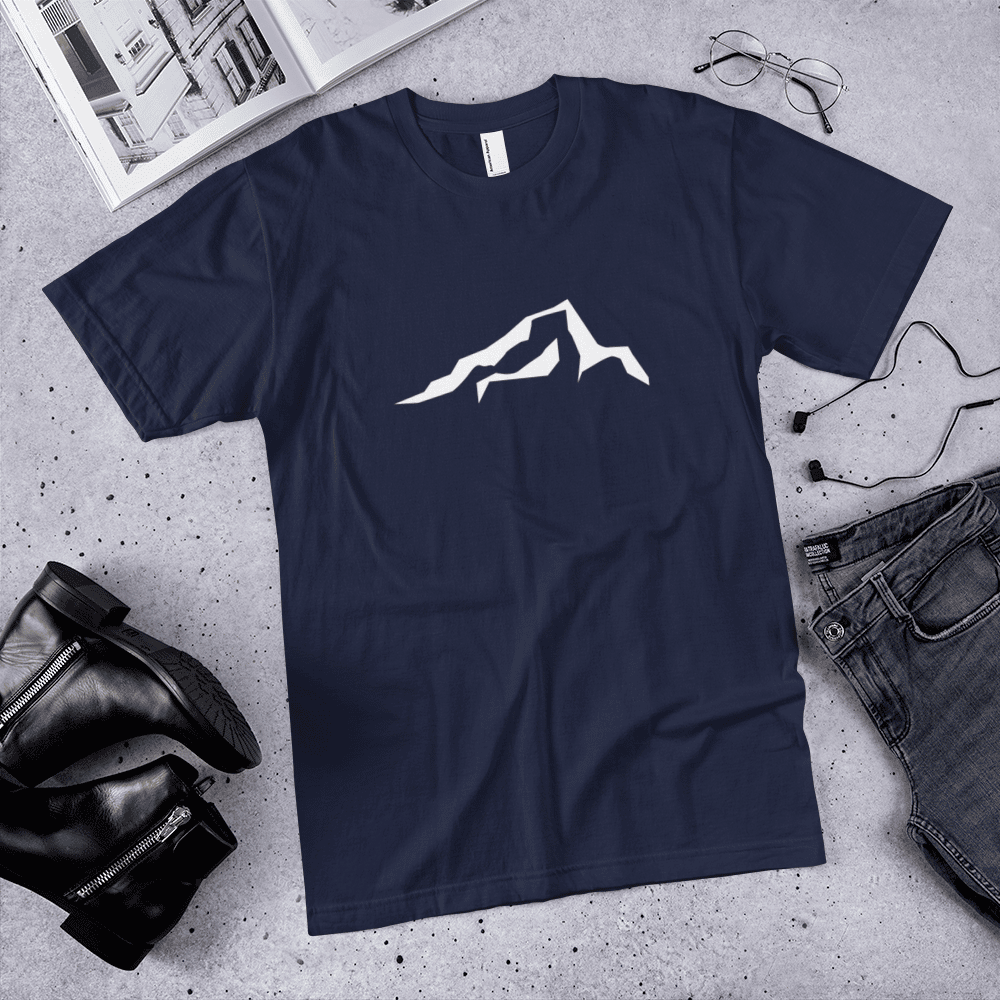
American Apparel T-Shirt with the Mountain emblem on the front. $30
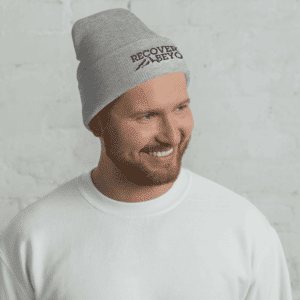
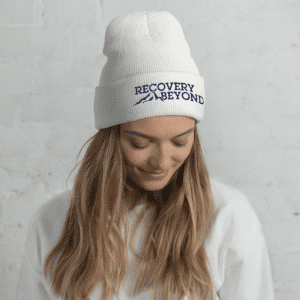
Unisex beenies in three colors – grey and white (shown) and navy with embroidered Recovery Beyond Logo. $20
Check out the entire line today!
SHOP THE STORE! -
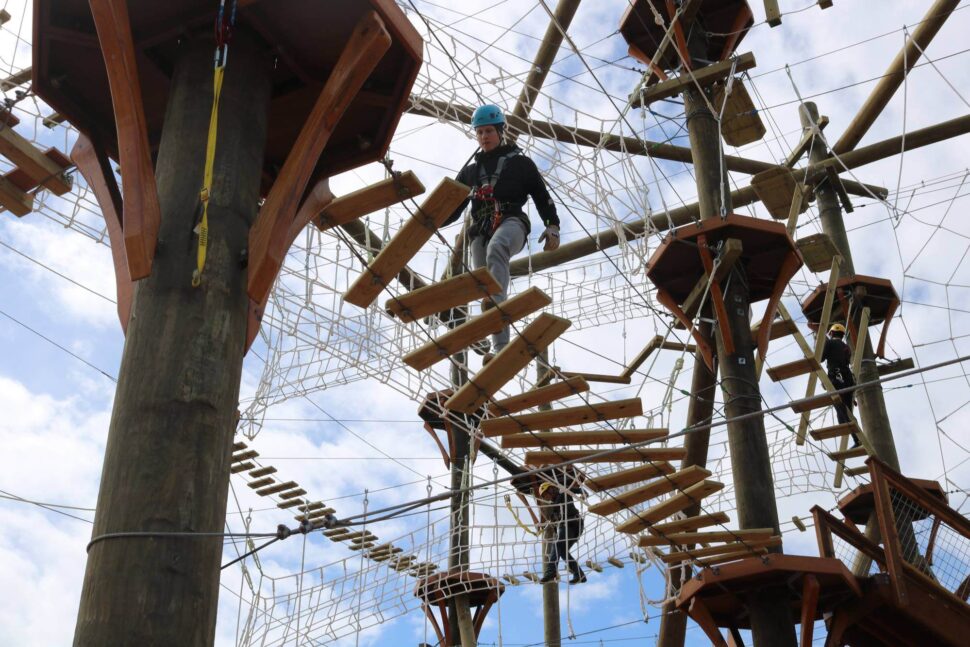
High Trek Adventures Supporting Recovery Beyond
We’re thrilled, literally and figuratively, to announce that High Trek Adventures is offering a promotional discount for anyone wanting to book an event with the company. Even better, they will be making a 10% donation to Recovery Beyond to support our recovery climbers and program participants.
If you are looking for a great place to have a team event that is lots of; full of energy and that everyone will love, this is an opportunity you don’t want to miss. If you have not been to High Trek Adventures, then you are missing a great adventure. Brad Halbach and his team offer an entire adventure park that is great for team building events or just a day of fun.
Want to know more? Check out this video they created for the promotion.
Click below to learn more about the promotion details and timing. Don’t miss out on a fantastic team or family event!
LEARN MORE @ HIGH TREK ADVENTURES -
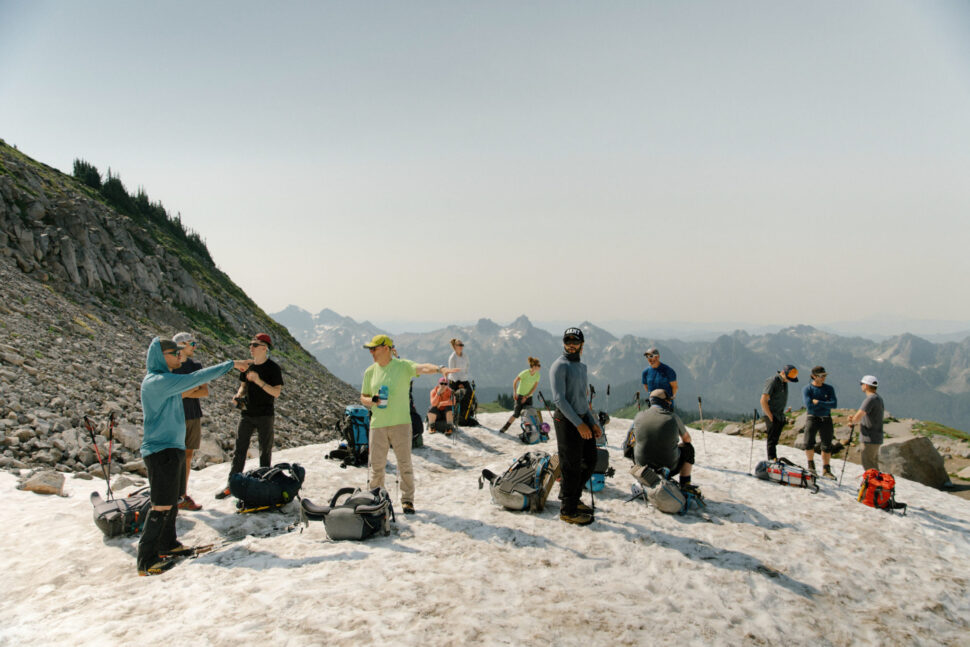
National Volunteer Month
In honor of National Volunteer Month, Recovery Beyond would like to recognize our hard-working, dedicated volunteers. From our six super volunteers, McKenzie Johnson, John Colver, Becky Vinson, Scott Sowle, Alison Powell, and Stephen Stanford, to our current group of growing volunteers, we appreciate you and everything you do. Without our volunteers, this organization would cease to exist. At the heart of any nonprofit are its passionate volunteers; individuals who carry out the work that needs to be done to meet the mission and vision of the organization. Recovery Beyond’s goal is to build “healthy lifestyles for lasting recovery”. Our model depends on people helping people. We simply could not do this work with our staff alone.
Healthy Lifestyles start with healthy relationships. There is a certain connection that happens when people come together with common interests, when they strike up a conversation, and when they discover that they share similar past experiences, challenges, and dreams. Because of these important connections, we have been seeing higher success rates with our program than any other treatment program. Our volunteers have stated that they receive as much from the interaction with the program participants as the program participants receive from the volunteers. It’s a beautiful story, really. Often the volunteer-participant relationship grows into a friendship, which then grows into a support system. There is mutual giving, sharing, and commitment to long-term sobriety and health. It’s real and it’s good for all of us.
Recovery Beyond has an impressive support network comprised of individuals from all walks of life, with different stories, experiences, and backgrounds, but with one similar goal: to be a positive support for our program participants. We are building a program that works and we are doing it with the help of our community – our volunteers.
Thank you to every volunteer, in every capacity, for everything you do. We appreciate your time, your dedication, your expertise, your experience, and your passion. You make a difference and this month, we celebrate and honor you.
Interested in being part of our positive, growing community to help those in recovery? Please check out our range of volunteer positions below. We’re excited to have you join us!
SIGN UP TO VOLUNTEER -
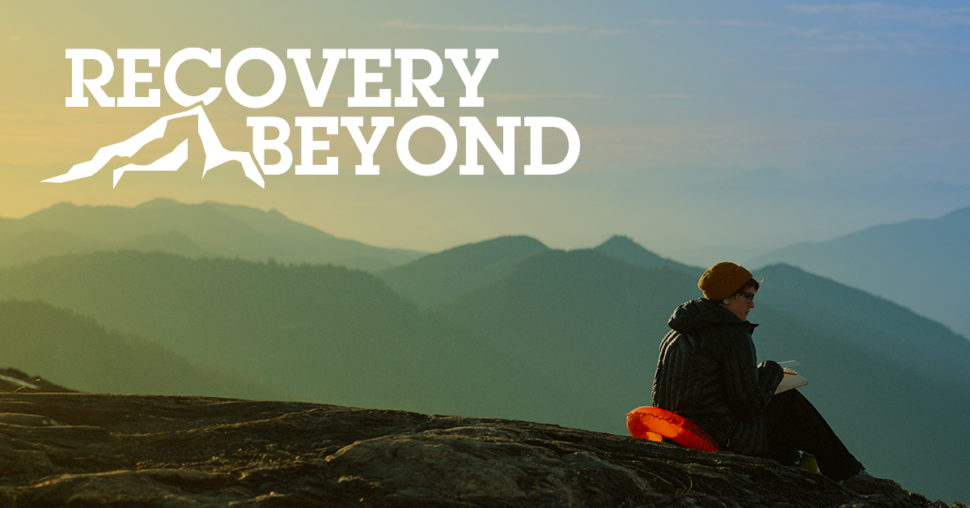
Go Behind Our New Identity
The team at Cora+Krist worked closely with Recovery Beyond leadership to determine the logical steps for evolving the Recovery Beyond Paradigm name and its program Climbing Out Of Homelessness. The next iteration had to be instantly recognizable and relatable to what the organization had already established. With so much great visibility from the Now This and REI films the organization was presented to 1 million people and their very active base came to identify with Recovery Beyond Paradigm, staying familiar was a key requirement.
Any change we took, needed to ensure that we paid tribute to the bold vision of Mark Ursino when he and Mike Johnson set out to create Climbing Out of Homelessness around a truly monolithic physical feat; climbing Mount Rainier. The original Climbing Out of Homelessness program logo encompassed a team of climbers scaling the mountain; the mountain had to continue to play an important part in the brand going forward.
Expanded Meaning in the New Brand
In any tough decision, the simplest path is usually best. It was natural for us to simply shorten the old Recovery Beyond Paradigm, to Recovery Beyond. It preserves established brand cache and value and helps position the organization for the next step in its evolution. We continue to help people move through recovery to their next stage of life; to a better self… to what’s ‘beyond’ addiction and homelessness.
Much in the same way, the Climbing Out Of Homelessness program naturally evolved to Climbing Out. Addiction is one of the root causes of homelessness, we work to alleviate addiction. Preventing addiction and homelessness remains our overall goal. So if there is no addiction problem, there is less of a chance of ending up homeless. It still represents the literal and figurative metaphor around the climb that our participants make on their journey out of addiction. Whether that climb is literally up the mountains in Seattle’s backyard or that climb is represented through other equally demanding physical activities – the struggles and triumphs are very much the same.
Logo Evolution for Recovery Beyond
For the new logo, we took to heart that we are evolving the organization; the evolution of an established presence. In that spirit, we sought to honor the key elements already employed; such as colors and typography, gracefully elevate these to evolve to a more quickly identifiable look.
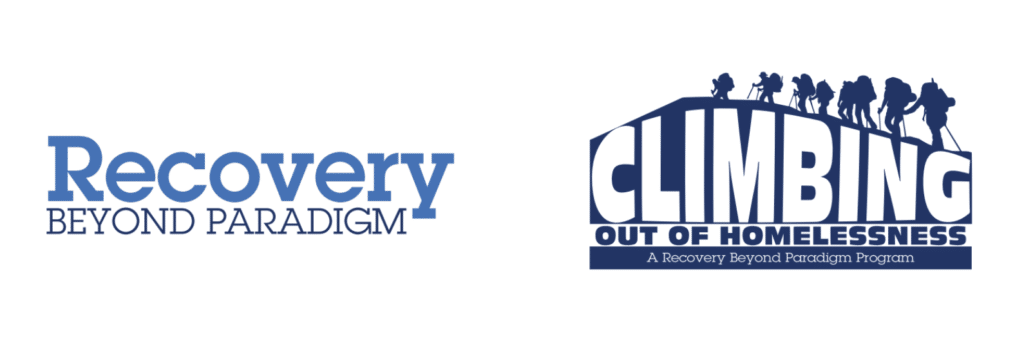

The result is a logo that, with a simpler name in place, balances on the bold variation of the typeface and incorporates the mountain so that the spirit of our founder’s original vision forms the foundation and reminder of where the organization started.
Graphic Design Elements ExplainedAdditional elements that you will see added to the brand include several gradients that emulate the start and finish of a person’s journey to sobriety. You will see these as subtle overlays on elements across our materials and within important activity buttons on the website.
Yellow to Blue illustrates the beginning of the journey to sobriety as the dawn of a new day.

The orange to yellow represents the fiery sunset experienced as one completes the journey.

The Story Of A Climb Through Photographs
Imagery has been refreshed in both historical photos provided by Mark Ursino, founder of Recovery Beyond and the photographs captured by Greg Balkin over the course of 2018 climb year. Together these images tell a visual story of our program; of the people who go through this journey and the countless volunteers that make it all happen.
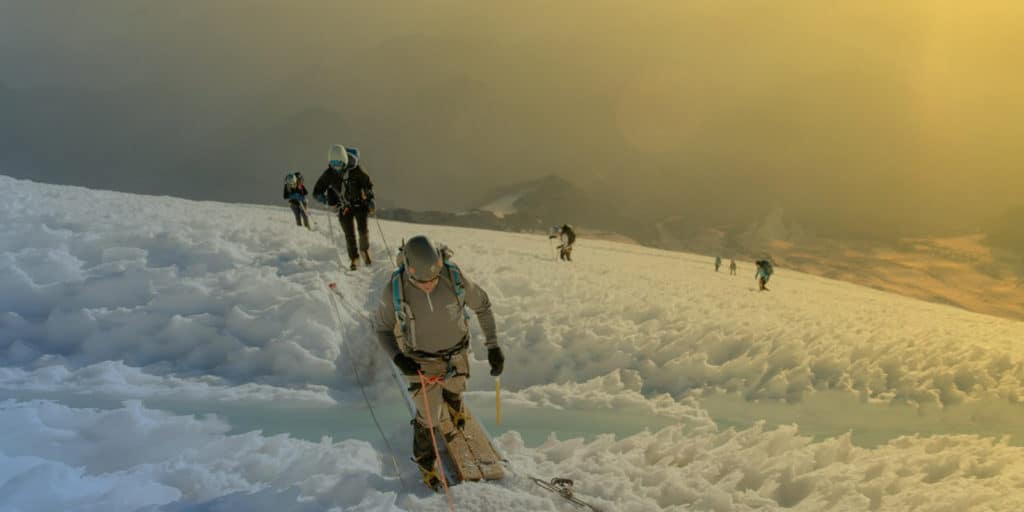
Image from a 2018 climb with the new dawn gradient overlay.
A New Tagline
Our new tagline perfectly captures who we are and what we’re about going forward:
Healthy Lifestyles for Lasting Recovery
This is really what we’re all about and as our programs begin to grow and evolve you’ll start to see this in action. We’re expanding beyond mountaineering to embark on numerous activities that help our participants embrace a healthy lifestyle. We know the key to lasting recovery is in living a healthy lifestyle and having a community to share it with. It’s a simple statement, but one that is direct and packed with meaning.
The final brand identity is a culmination of intensified thought, powerful meaning, and emphatic dedication. This will be a powerful imprint that will continue to impact the lives of many who wish to embark on a climb like no other in their life, centered around a healthy lifestyle and a supportive community, to reach lasting recovery. Building a better future starts with the first step.
Program Spotlights
Recovery Beyond > Program Spotlights
